MG IM6 Performance 2025 Review
MG makes an ambitious leap into Tesla Model Y territory, but the flagship version suggests it falls well short of the best-selling EV’s mark
Another day, another new Chinese brand … and another challenger looking to steal sales from the Tesla Model Y.
The IM6 is a coupe-style, luxury-pitched SUV from IM – a brand that stands for “Intelligence in Motion” and launched in 2020 as a JV between Chinese car-making giant Shanghai Auto (SAIC) and e-commerce titan Alibaba.
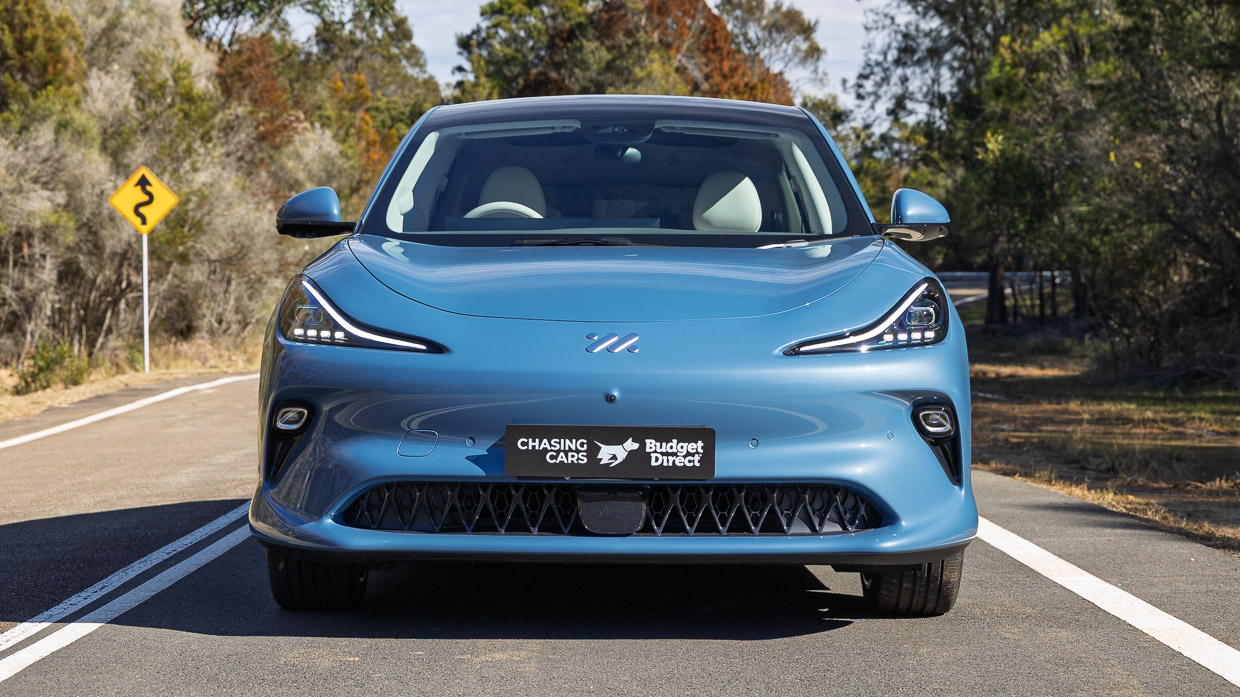
SAIC has acknowledged the difficulty of launching an unknown name into an overseas market by putting IM under the umbrella of its most established brand in Australia – MG. (It’s done the same in the UK.)
So there’s IM Presented by MG Motors branding, and an “MG Motor” badge has been applied to the rump of both the IM6 and its simultaneously launched sedan twin, the IM5. This differentiates them from the Chinese market, where they’re respectively known as the IM LS6 and IM L6.
The IM models are featured on the MG Australia website, though are the only models not to feature an MG prefix – and clicking either the IM5 or IM6 takes browsers to a more sophisticated-looking web hub to match its premium-brand aspirations.
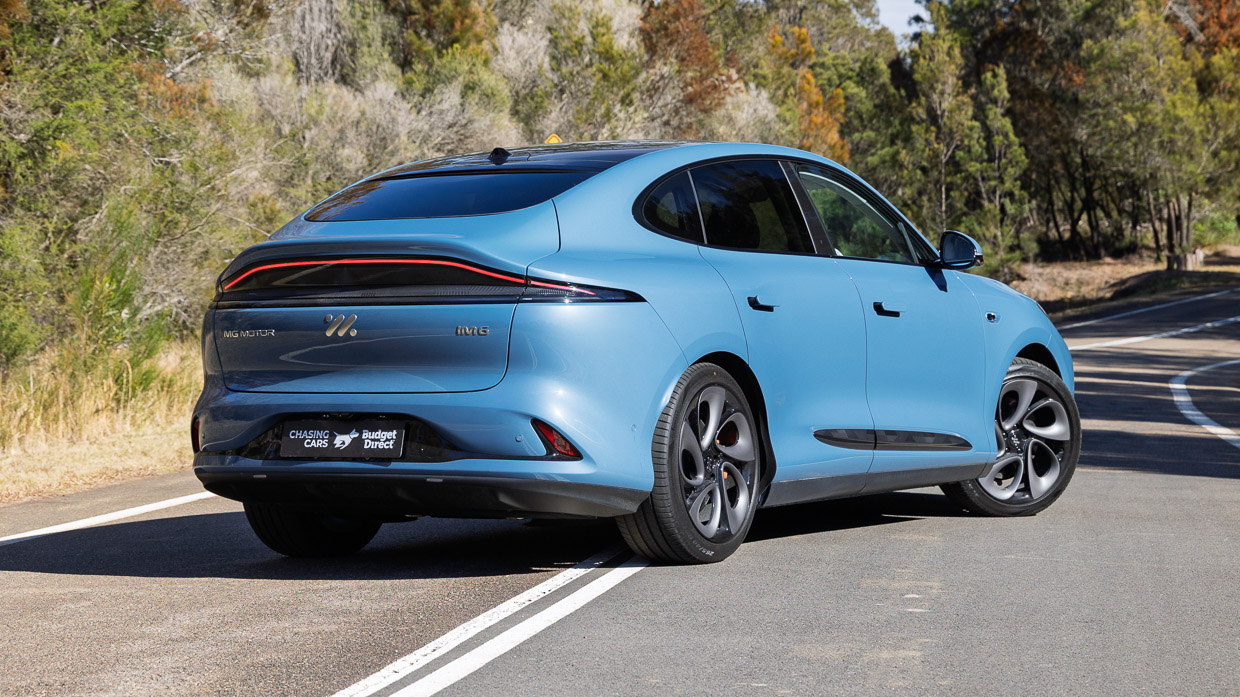
We’ve chosen to refer to the vehicles as the MG IM6 and MG IM5.
Read on to find out whether the IM6 is a worthy rival for the best-selling electric SUV in Australia. Our review focuses on the only variant made available for initial testing, the flagship Performance.
What are the IM6 Performance’s features and options for the price?
The IM6 essentially mirrors the IM5 sedan, including the same tri-grade line-up and pricing.
The IM6 Premium base model features a 400-volt platform, a 75kWh LFP battery, and a single electric rear motor, with drive-away pricing set at $60,990. That compares with the base (RWD) Model Y that costs $64,120 drive-away (Sydney postcode).
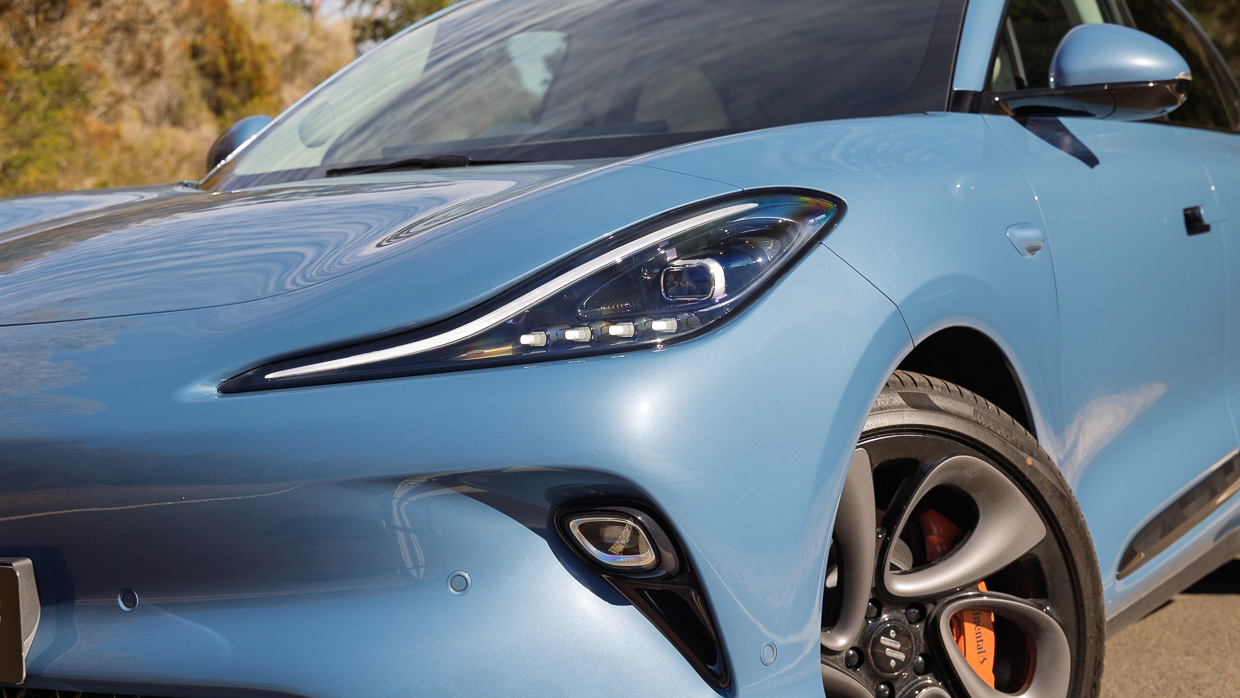
Mid-range Platinum and top-spec Performance variants share an 800V electrical architecture promising faster charging and better efficiency, as well as a larger battery – 100kWh NMC. They’re primarily differentiated by their electric-motor count, with a single motor for the rear-drive Platinum and dual (front/rear) motors for the all-wheel-drive Performance.
The Platinum is priced at $69,990 drive-away, with a $11,000 jump to the Performance ($77,990 list, $80,990 drive-away) that adds a front electric motor, air suspension, and “continuously controlled” dampers.
Tesla’s equivalent Model Y to the Platinum costs $74,610 drive-away (Sydney postcode) to be undercut as well; the US brand’s own flagship Performance variant is out later this year. Elsewhere, the dual-motor BYD Sealion 7 Performance, at $63,990 list (or around $67,500 drive-away), appears a relative bargain.
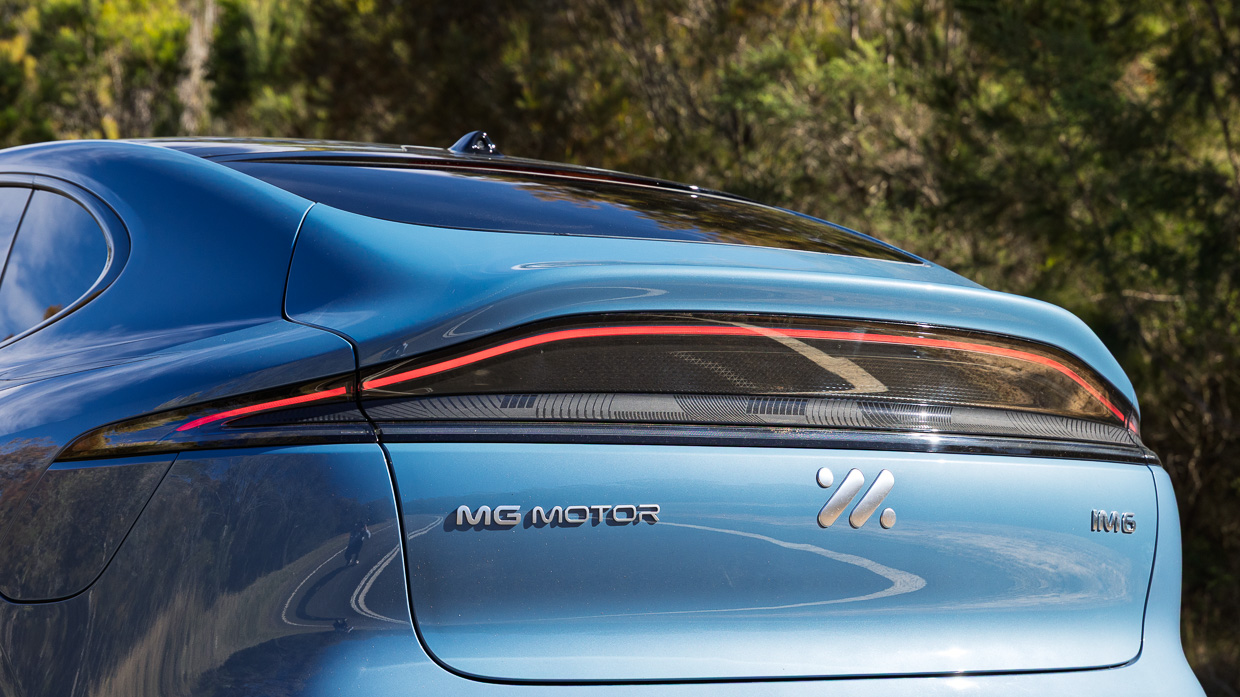
Platforms and powertrains distinguish the IM6 range more than equipment. Every grade comes with virtually identical equipment, the highlights of which include:
- Full-length glass sunroof with heat reduction
- 26.3-inch panoramic digital display comprising infotainment and driver cluster
- 10.5-inch central touchscreen
- Rear-axle steering
- Road Noise Control
- Wireless smartphone integration
- Ventilated phone charging
- Artificial-leather upholstery
The Premium sits on 20-inch wheels wrapped in Pirelli Scorpion tyres, while Platinum and Performance models feature 21-inch wheels with Pirelli P Zero rubber.
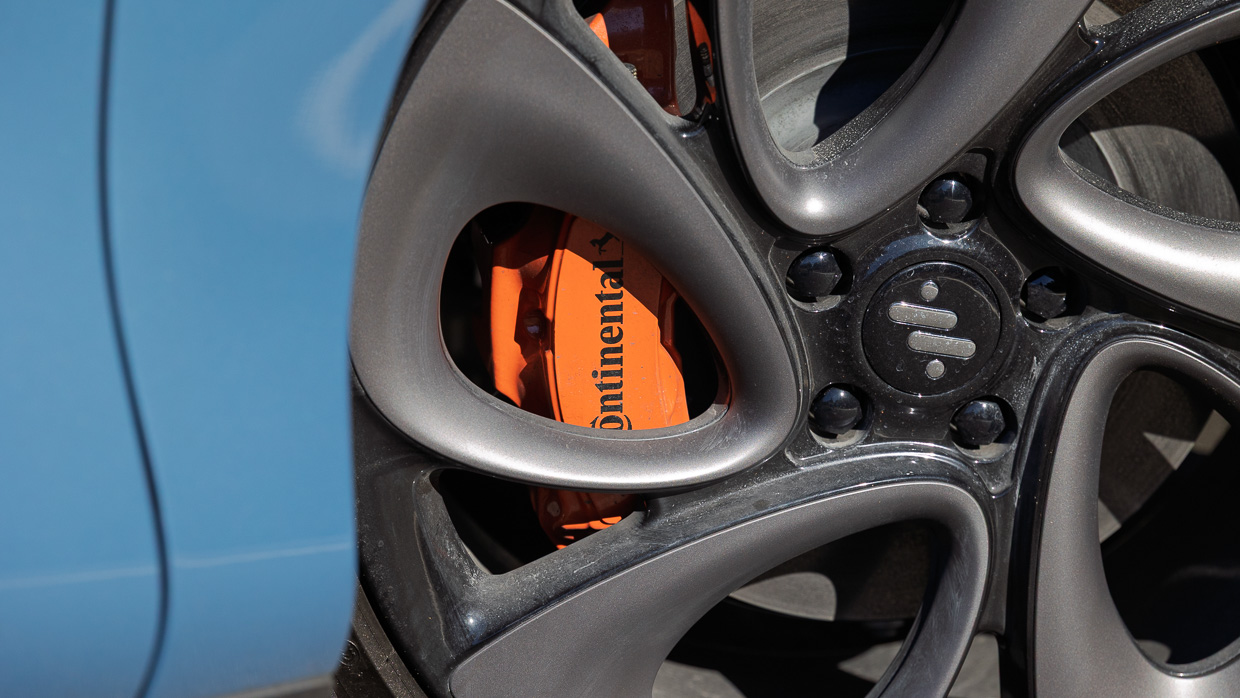
All modes have Continental front brakes.
There are Range Rover Velar-inspired pop-out doorhandles that also feature power release – unlatching upon sensing fingers going through the handle. There are also frameless doors with double-glazed glass.
The IM6’s styling looks awkward from most angles, despite a rear end that borrows heavily from the Aston Martin DBX. It’s no match for the handsome looks of the rival BYD Sealion 7, while the twin IM5 sedan has significantly better proportions.
What is the IM6 Performance’s interior and tech like?
With the exception of the outlier MG Cyberster electric roadster, the IM6’s cabin presents with a higher level of perceived quality than anything else in the MG portfolio. This is helped by the extensive use of artificial leather on the dash, doors and seating.
Our test car’s off-white, square-padded upholstery looks like it should be called Asylum spec, though the optional trim is officially named Dover Beige. It costs $990 despite being a free choice in the UK. The standard interior colour is Highland Grey.
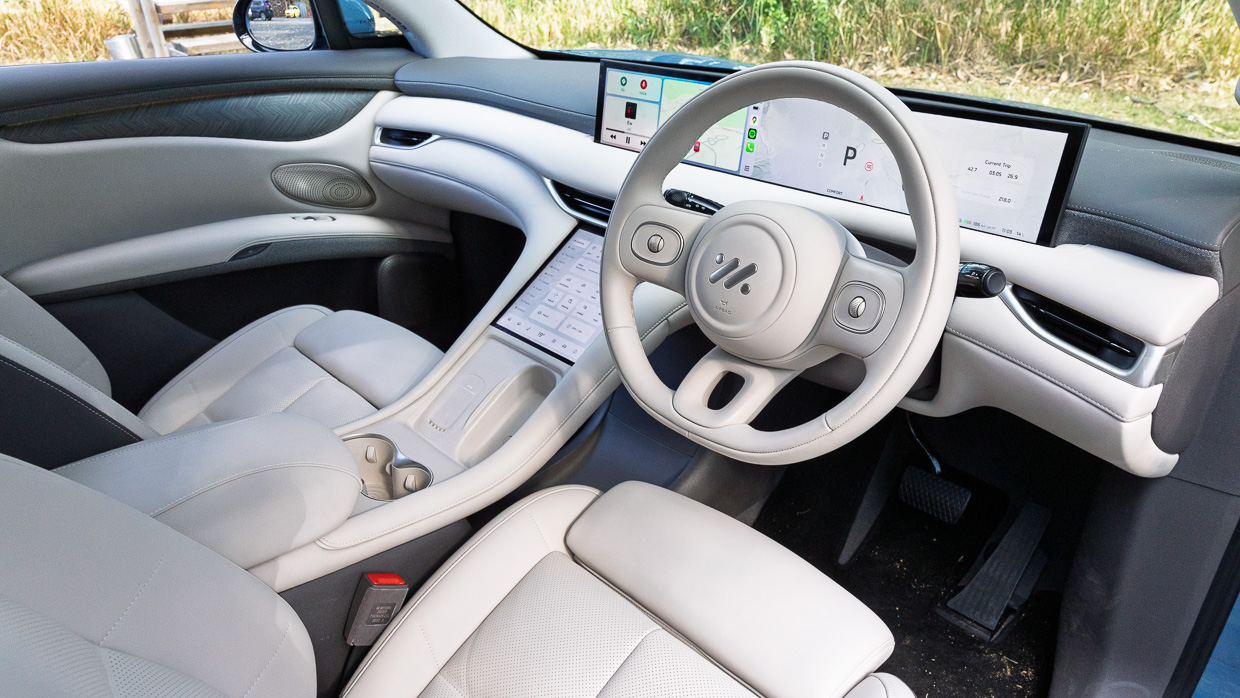
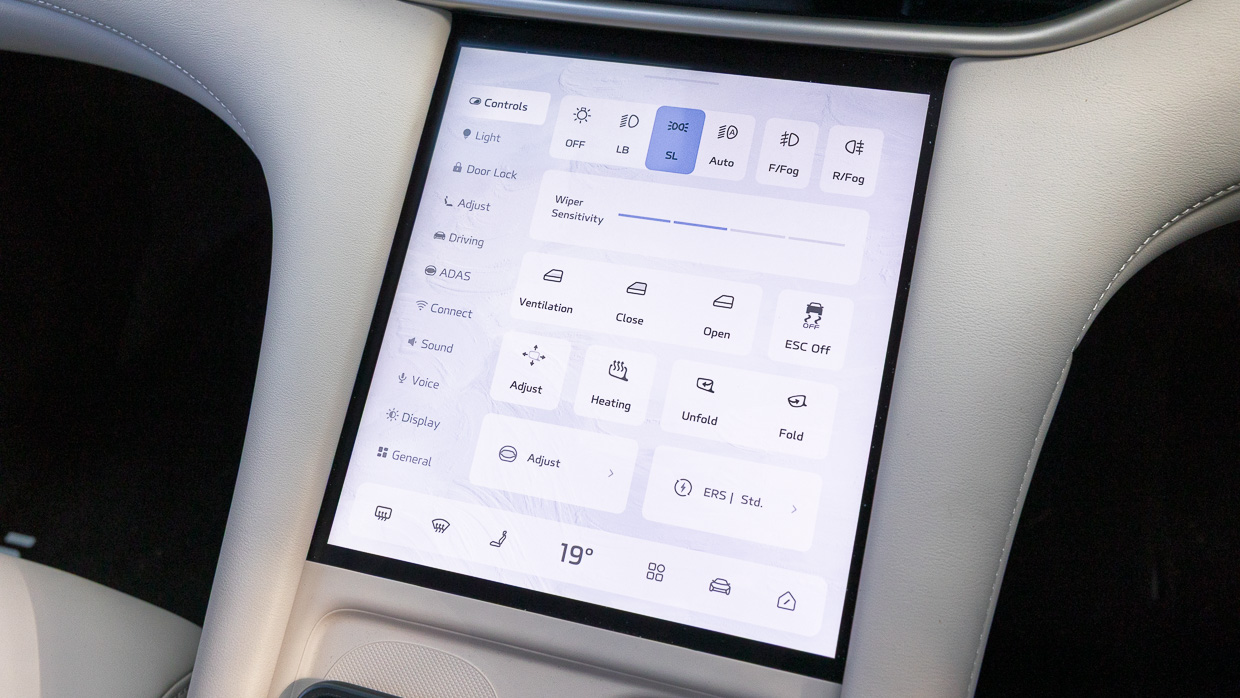
A 26.3-inch panoramic digital display unit stretches out across the top of the dash and comprises an infotainment touchscreen and driver information cluster. A lower, central touchscreen, that measures 10.5 inches, sits on the raked centre console, a design format that will look familiar to any Porsche Taycan owner.
This digital display houses a multitude of functions including vehicle controls, driving modes, climate control, and driver assistance systems. It means there’s a dearth of physical switchgear, which is essentially limited to steering wheel stalks and paddles, and window switches.
The premium-interior ambition is not fully realised, however. The only genuine leather is found on the steering wheel, and cheaper plastics are conspicuous at a lower cabin level, including the large storage area under the centre console.
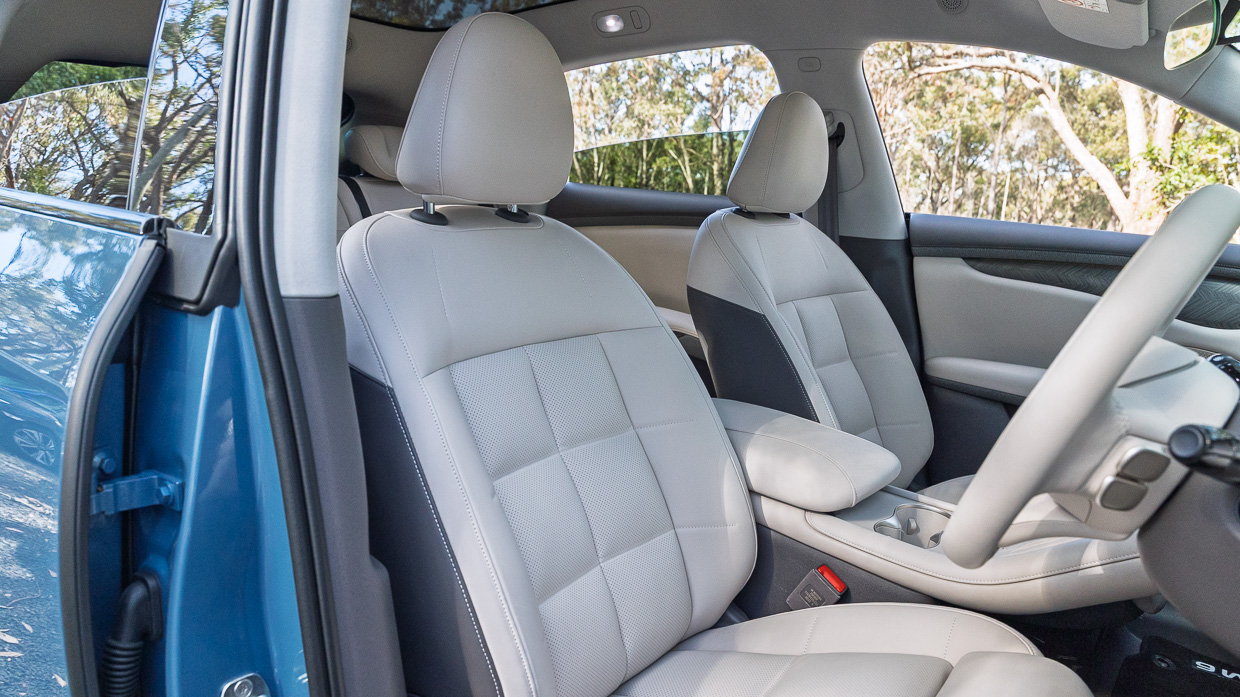
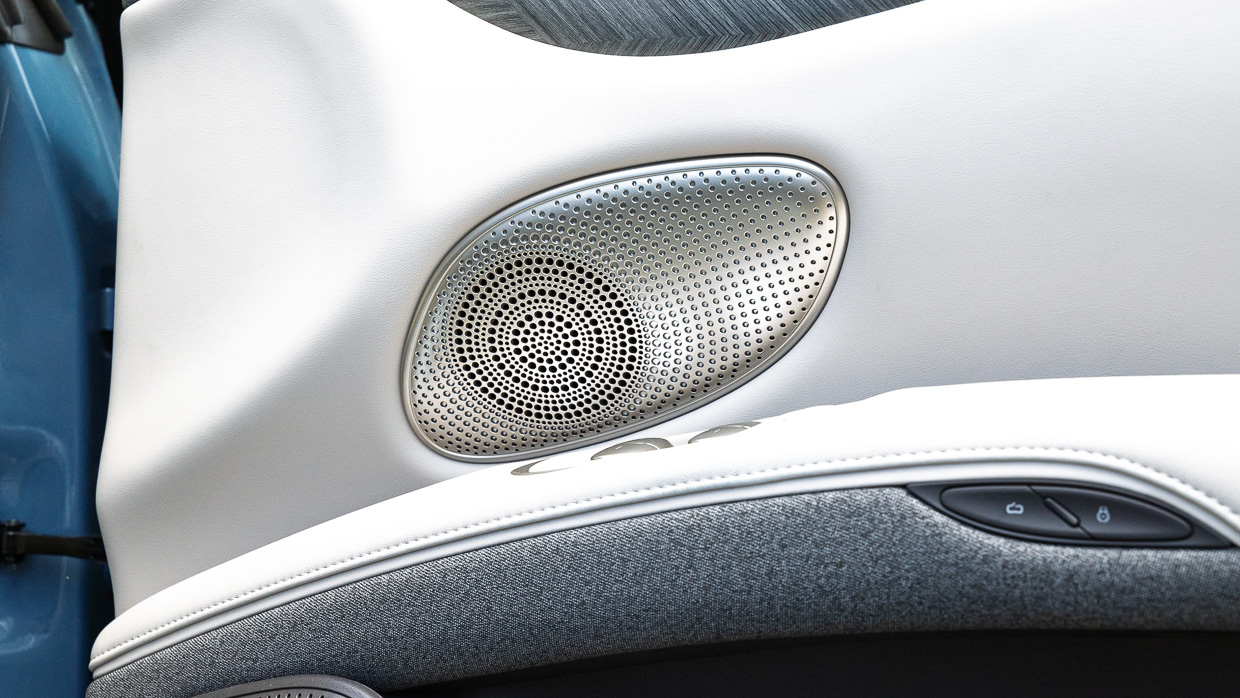
While the metallic upper door speaker looks classy, the lower door speaker is a moulded square of hard plastic. More extensive electric seat adjustment would be ideal, too.
The IM6 SUV puts its extra height to good use when it comes to the rear seat, where adults find a significantly more comfortable set-up than in the IM5 sedan. The higher rear bench provides a more natural sitting position (if not perfect under-thigh support) as well as greater foot space under the front seats, complementing the good knee space and generous headroom.
Rear seatbacks come with multiple recline positions, and the middle seatback folds down almost in its entirety to provide a large armrest (larger and different to the rear armrest in the IM5) with cupholders and smartphone slot.
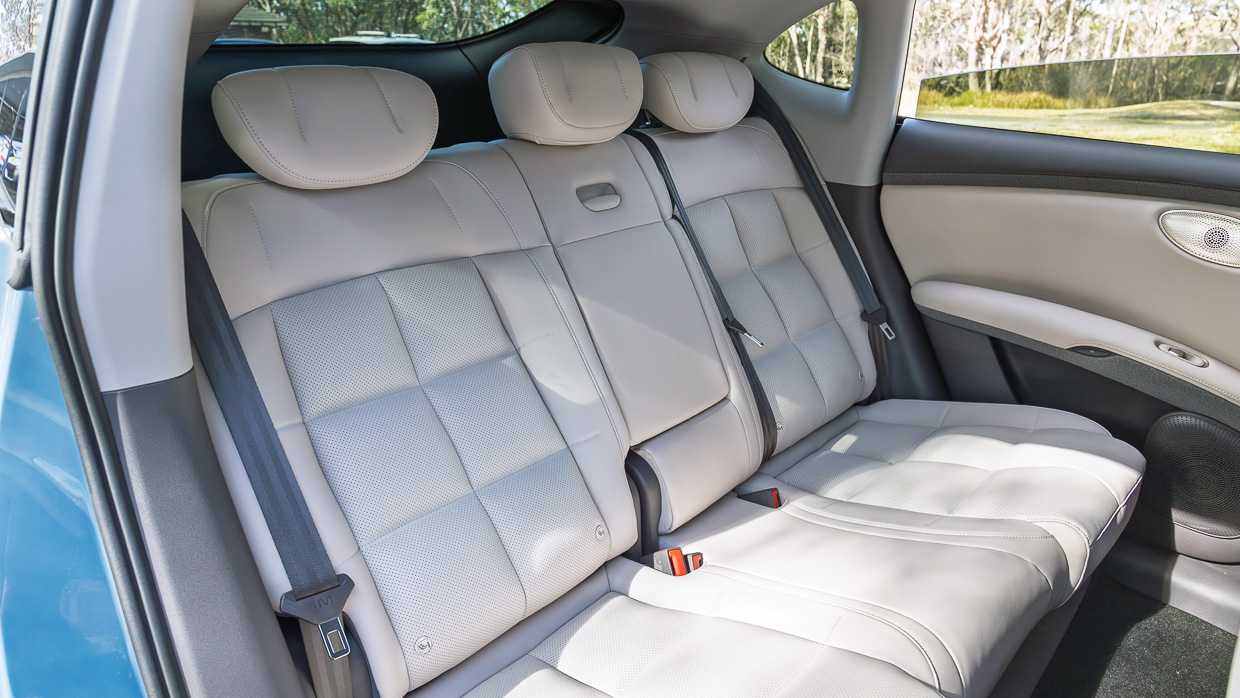
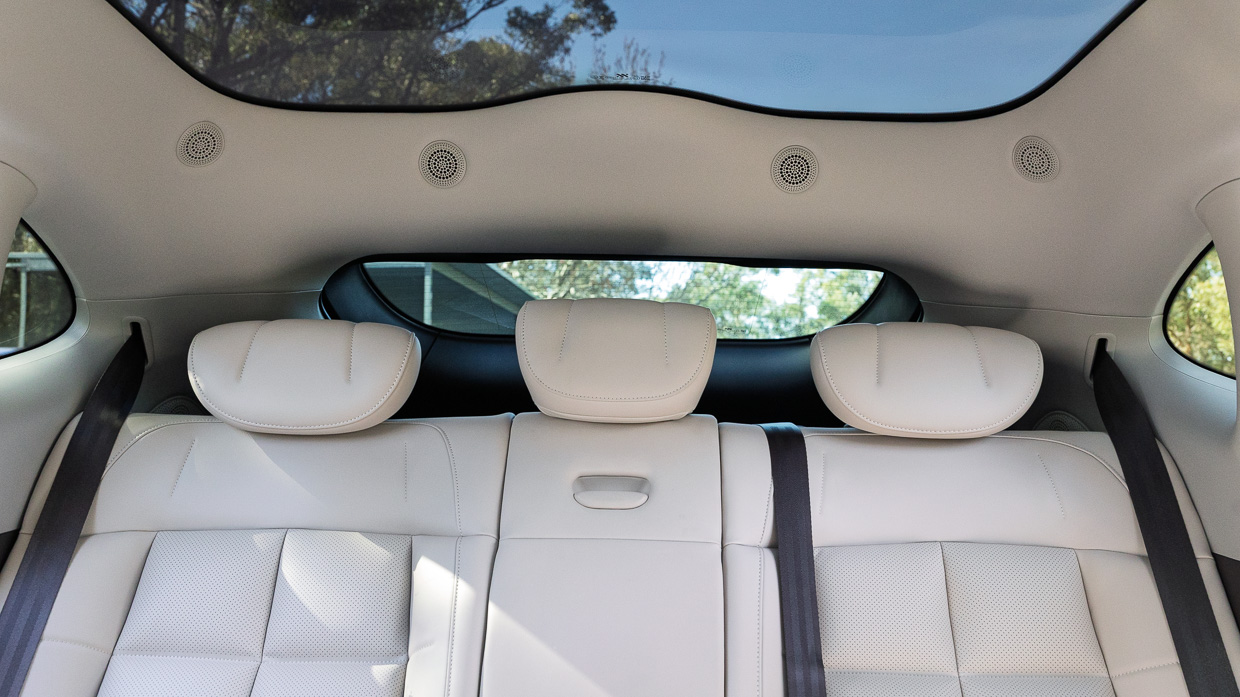
Plentiful cabin light comes courtesy of the full-length glass roof that’s tinted, rated for high UV protection, and has heat reduction so you don’t burn yourself on the glass on a scorching hot day. (We’d need to drive the IM6 in summer rather than winter to test it out, though an accessory sunroof blind is available if preferred.)
A single USB-C port could start fights in the back seat, though IM Mag ‘docks’ on each seatback can cater for MagSafe iPad holders – however, MG/IM’s own magnetic accessories are currently limited to one option.
Does the IM6 Performance come with a practical boot?
Although the IM5 sedan has a liftback design, the IM6 SUV has significantly more cargo capacity – 646 litres (in the case of the Performance version) compared with 457 litres.
Other IM6 variants without air suspension have a slightly bigger boot – 665L.
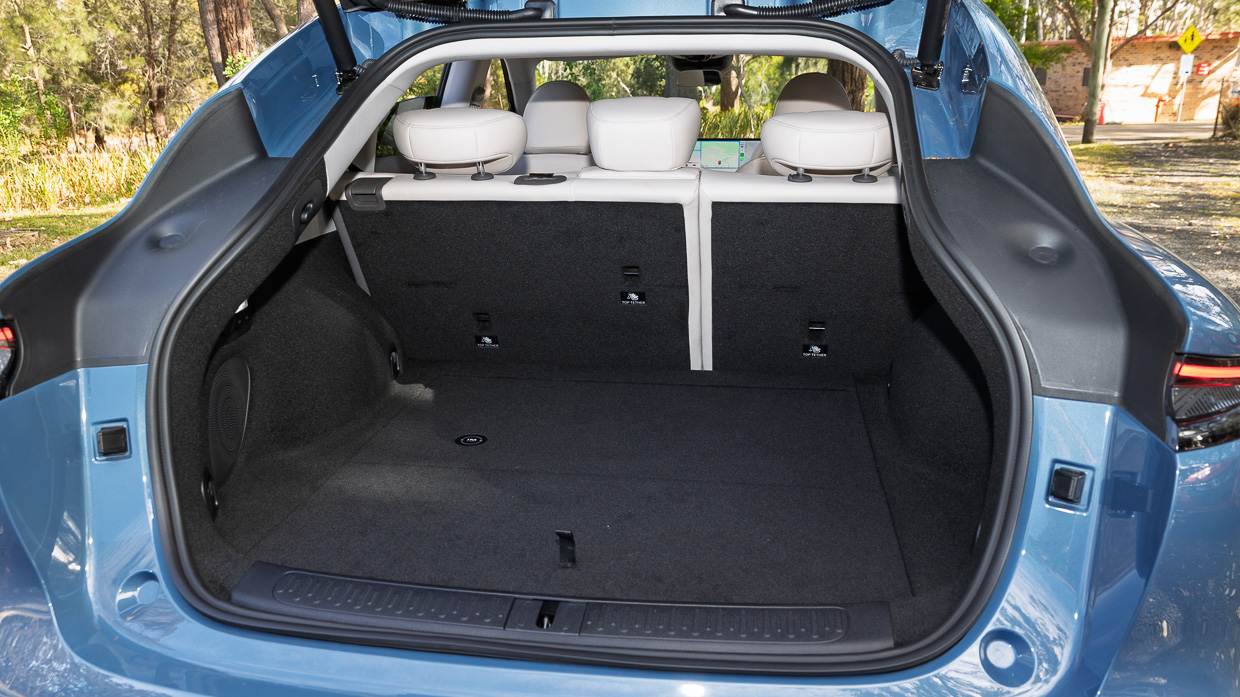
Either way, the figures fall well short of the Model Y’s quoted 864L, though Tesla does seem to measure boot space differently to most brands.
The IM6 misses out on the Model Y’s power-folding/retracting rear seatbacks, though the air suspension allows the loading height to be electrically raised/lowered by boot buttons. There aren’t manual release levers, either, and the 60-40 seatbacks don’t fold fully flat.
An underfloor storage area is an upside but the fitment of a tyre repair kit rather than proper spare wheel is a downside.
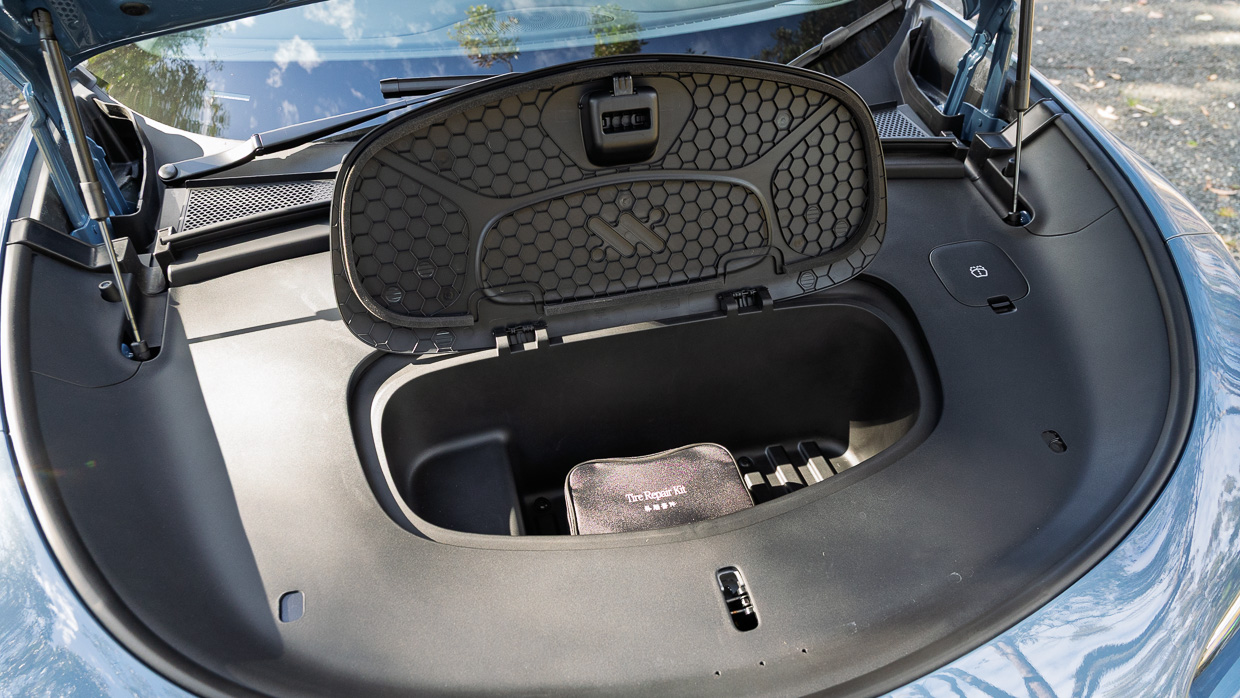
Meanwhile up front, there’s a small frunk under the bonnet, if noticeably smaller than the Model Y’s front storage compartment.
How does the IM6 Performance drive?
We may have joked about the asylum-cell seats, but they won’t drive you mad for lack of comfort thanks to their plump padding. There’s also a manual cushion extender on each of the front seats – a feature you strangely don’t get on the IM5.
What is likely to send you crazy is the constant stream of audible ‘bings’ and ‘bongs’ from the IM6’s driver aids, which also leave you guessing what the car is trying to warn you about as no words or symbols appear on the central display. The lane-keep system can also be intrusive, tugging at the steering wheel even when you’re centred in a lane.
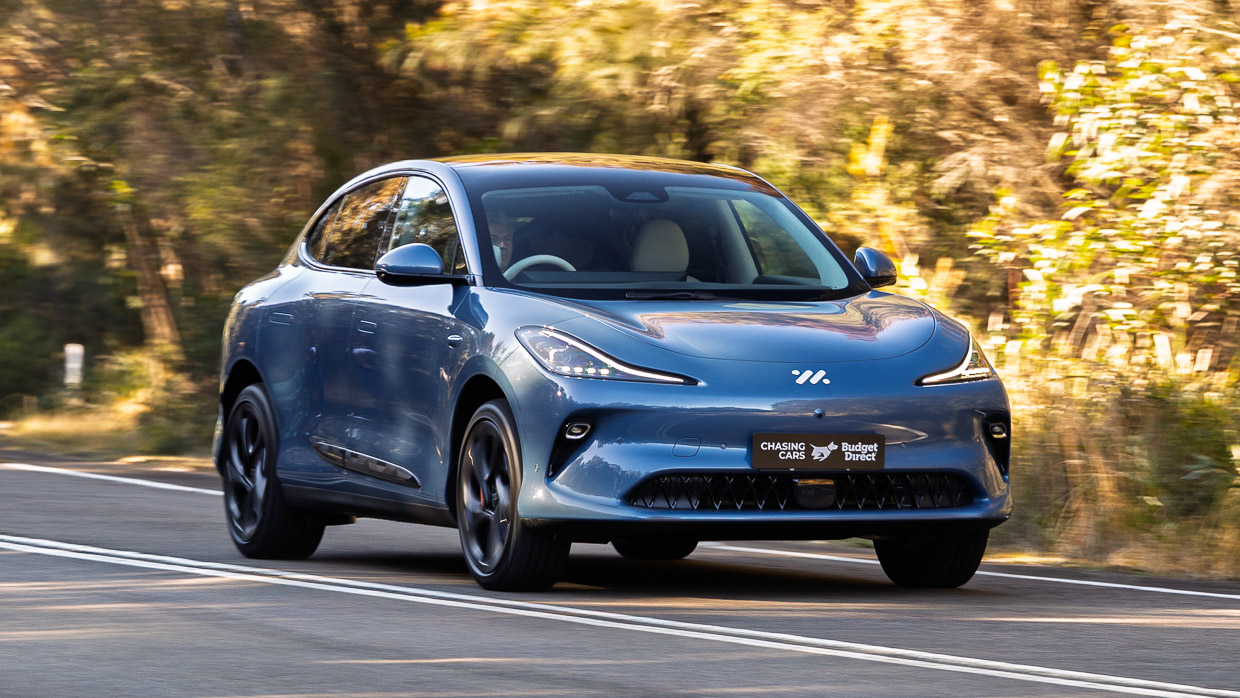
They can be switched off by finding the right menu on the central touchscreen, or pressing the right-side thumb scroller on the steering wheel as a shortcut to an ADAS page. However, all systems revert to On status whenever the car is started.
The driver display mirrors Tesla’s Autopilot imaging with graphic replications of other motor vehicles as well as pedestrians. A key difference is that the MG positions it far more helpfully, directly ahead of the driver.
But there are still too many functions buried in the central lower touchscreen, yet the driver monitor camera will ping you with a distraction warning if it thinks you’re not paying adequate attention to the road. (At least Tesla’s functions-intensive central touchscreen is closer to eye level.)
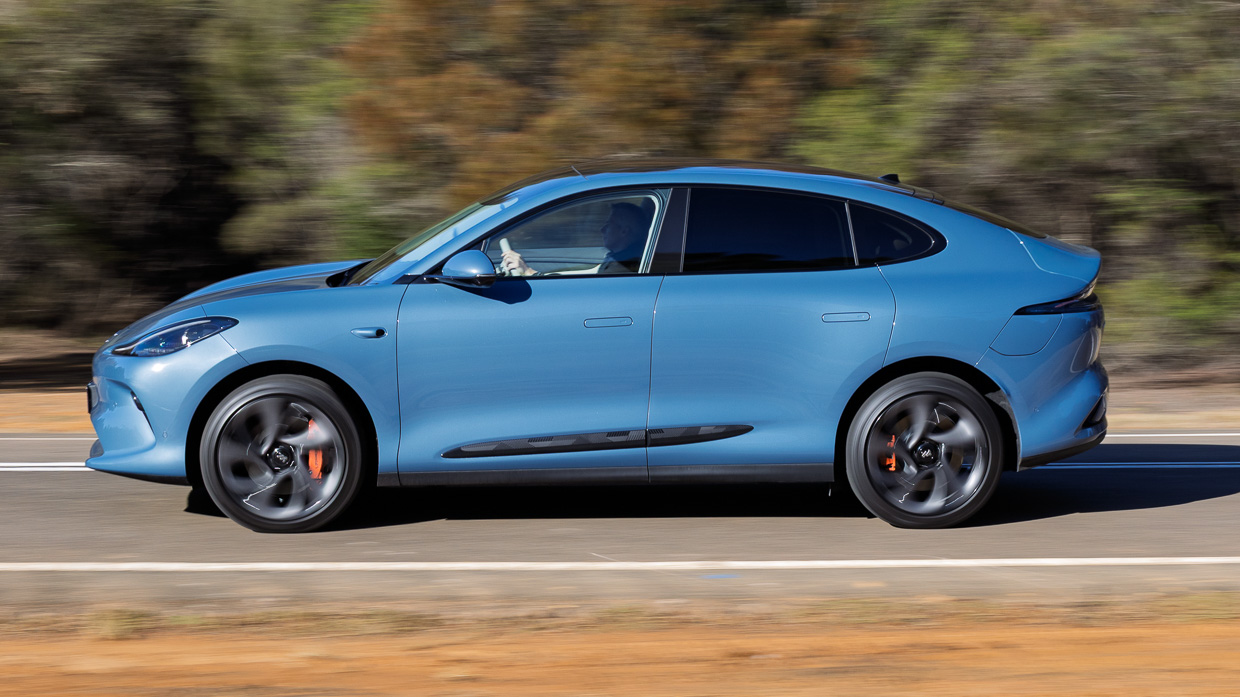
Rear vision is terrible (and it’s little better in the IM5), but at least this has been recognised by the car maker with a rear-camera video feed available with a flick up of that aforementioned thumb scroller. The driver is even given the unusual option of being able to fold the rear-view mirror away.
And as with many Hyundai and Kia models, flicking the indicator stalks activates respective side camera video feeds to the panoramic digital display. These are also engaged in Rainy Night Mode to help vision in trickier weather, a feature that also initiates windscreen and rear screen defogging and heating.
For nervous parkers, various One Touch parking modes are available to enlist the car’s help.
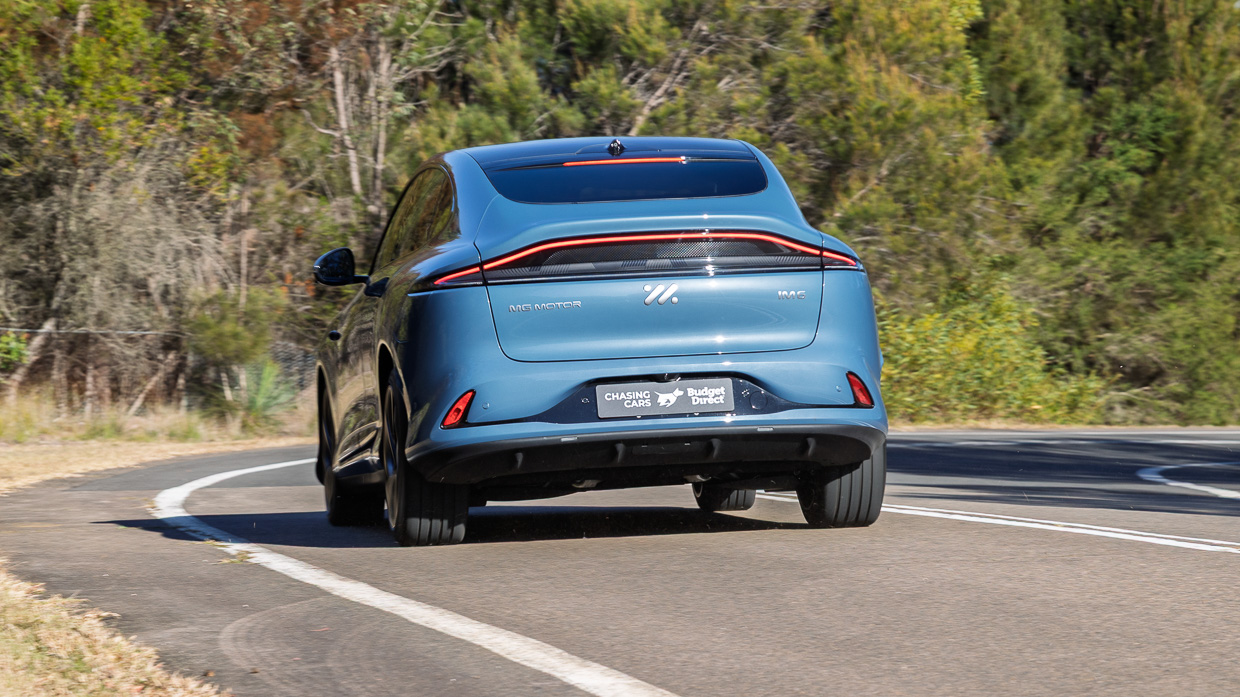
There’s even a Crab mode, which allows the driver to steer the IM6 in a diagonal direction at very low speed – using the standard rear axle steering. Turning the rear wheels up to a maximum of six degrees, Rear Wheel Steering makes this near-five-metre-long SUV ridiculously easy to manoeuvre around cities and suburbs.
If only the IM6 Performance’s air suspension coped better with typical urban and suburban road surfaces. Depending on surface and speed, the ride is either knobbly or lumpy, while potholes and bigger hits send uncouth judders through the cabin.
We’ll have to wait to see if IM6 models on regular steel springs – and missing the Performance’s fancier damping system – provide more comfort. Or handling that is more inspiring.
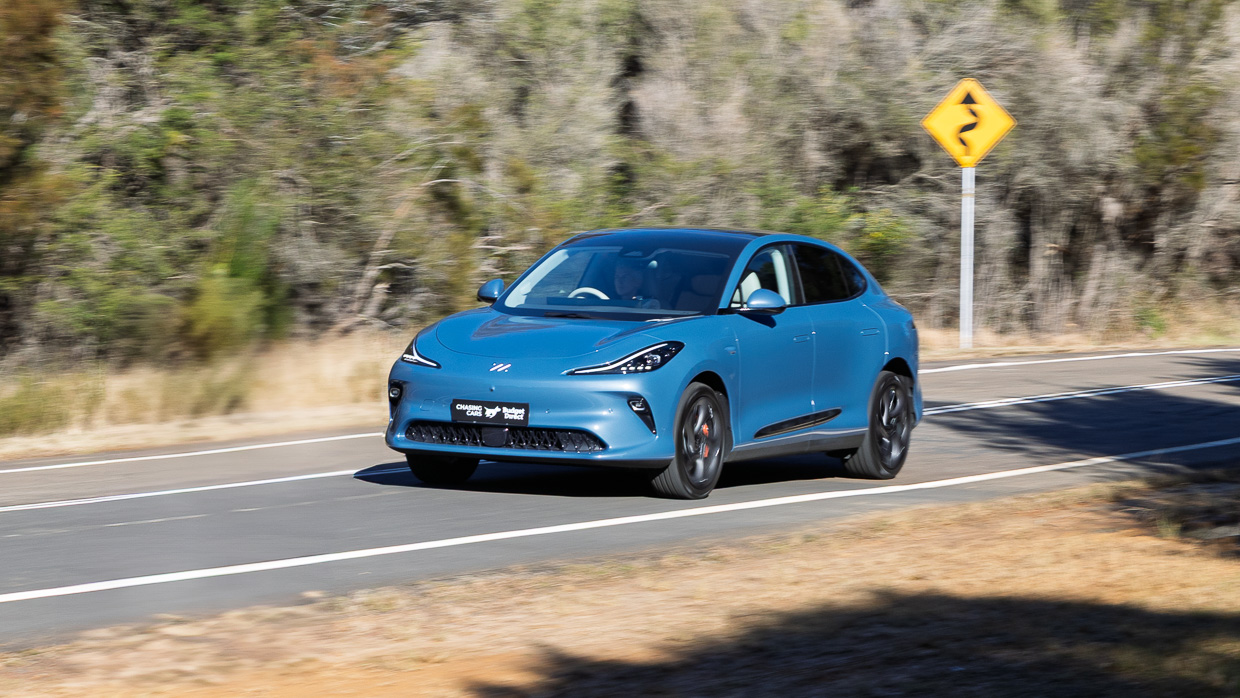
MG’s electric large SUV doesn’t lack for cornering grip thanks to its Pirelli P Zero rubber, but – even with the ride height lowered in Sport mode – it leans aplenty in corners and the chassis doesn’t convince in directional changes.
There’s lazier turn-in compared with the IM5 sedan that offers the keen driver noticeably more, with its generally sharper responses and more planted feel – yet also a better ride.
The IM6’s regen braking is surprisingly mild, so it’s an SUV driven primarily with two pedals where the rival Model Y can be driven predominantly with a single pedal. The transition to the Continental braking system is seamless, however, making it easy to bring the IM6 to a stop smoothly.
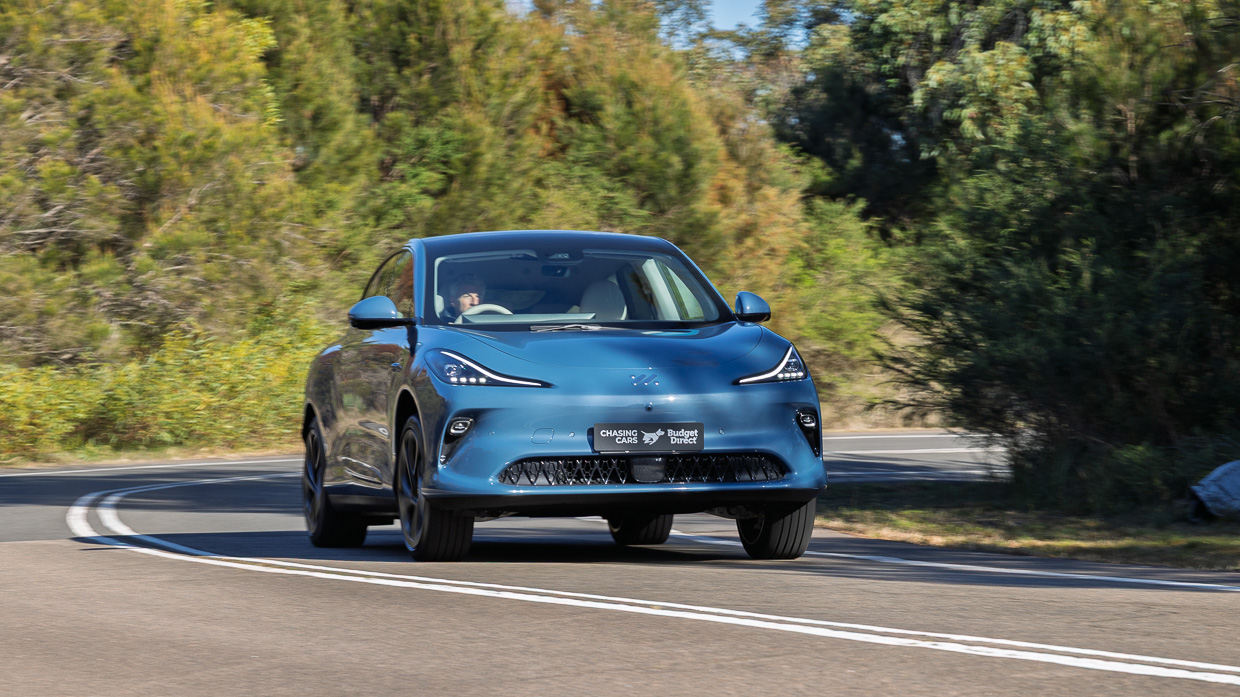
Just leave the Brake Force settings in Normal – the Sport mode here makes the brake pedal too sharp.
The IM6’s cabin is relatively peaceful on country roads or freeways, benefitting from two key factors: double-glazed glass for the side windows and panoramic roof, and road-noise-cancelling tech applied through the cabin’s 20 speakers. The most noticeable noise is the whirring from the electric motors.
There’s no doubt the IM6 Performance lives up to its name. With a front electric motor producing 200kW/302Nm and an even more powerful rear motor producing 373kW/500Nm, this all-wheel-drive SUV accelerates from 0-100km/h in 3.4 seconds. That’s the claimed time, though we also matched this in testing (3.41sec to be exact).
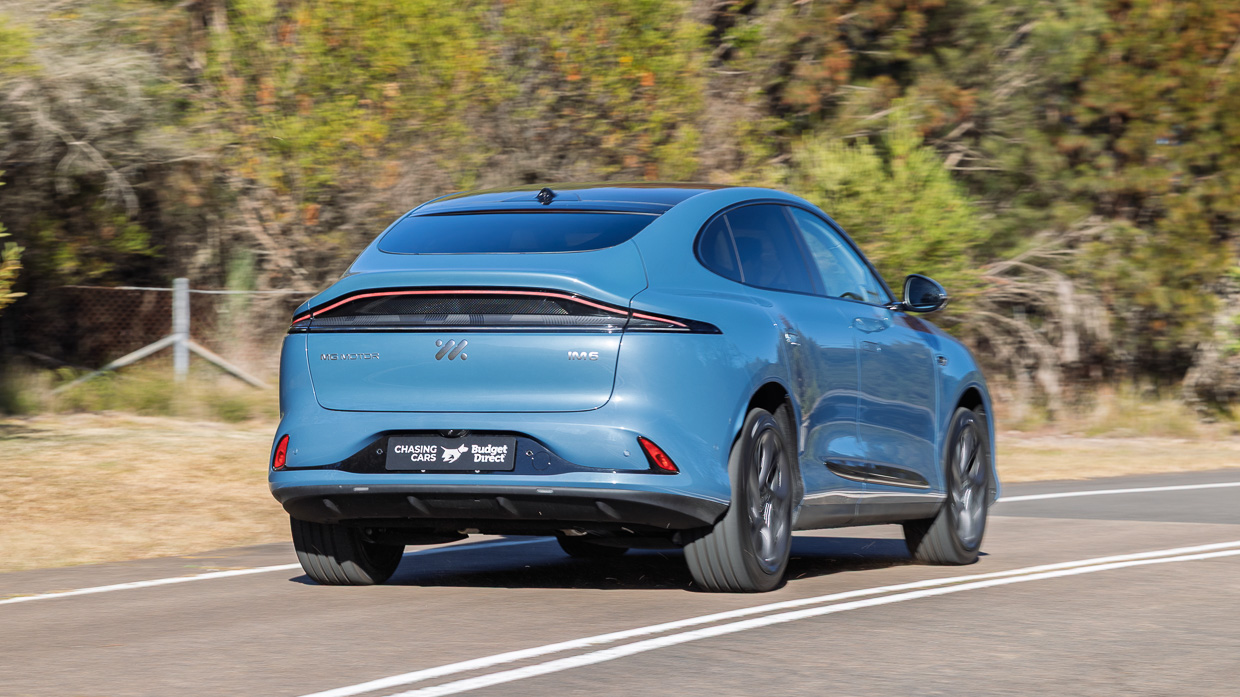
This acceleration is at its most manic in Sport mode, with Normal mode providing a nicely progressive power delivery for everyday driving. The rear-drive Platinum is still quick at 5.4sec claimed, with the Premium quoted at 6.8 seconds.
Tesla has yet to release the Performance version of its updated Model Y, but is expected to be as quick, if not a little quicker, than the IM6 Performance. The Model Y Long Range AWD has a quoted 0-100km/h time of 4.8 seconds, while BYD’s fastest competitor, the Sealion 7 Performance, comes with a 4.5sec claim.
What battery range does the IM6 Performance offer?
The 800V IM6 models are the pick if you want a WLTP-cycle range of more than 500km. You’ll go furthest with the mid-range Platinum’s 555km, with the Performance listed at 505km. Meanwhile, the smaller-battery, 400V IM6 Premium has a 450km WLTP range.
Tesla’s Model Y beats comparable grades, with the RWD quoted at 466km and the Long Range AWD well ahead with 600km. The American electric SUV’s efficiency has also regularly proven to have excellent battery efficiency, which doesn’t appear to be the case with the IM6 – at least in the case of the Performance flagship.
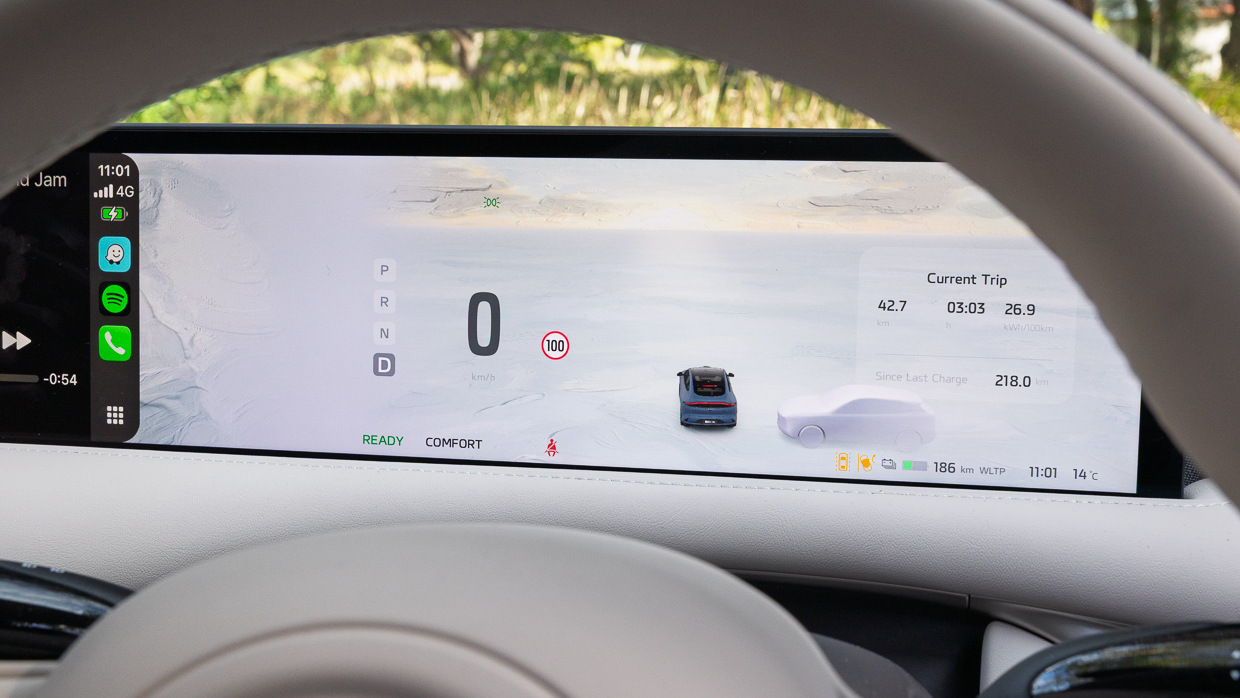
We achieved an average of 22kWh/100km over four days, with most shorter trips showing surprisingly higher results – as high as 25.9kWh/100km. Based on the average efficiency, the IM6 Performance would deliver a real-world range of just over 450km.
For another relevant comparison that falls in the IM6’s favour – at least on paper – compatriot electric SUV the BYD Sealion 7 has WLTP ranges of 482km and 456km for its rear-drive Premium and all-wheel-drive Performance models, respectively.
Is the IM6 Performance a safe car?
There are no Euro NCAP or ANCAP crash ratings yet for the IM6 (or its IM5 twin), no doubt owing to the newness of these vehicles outside of their domestic market.
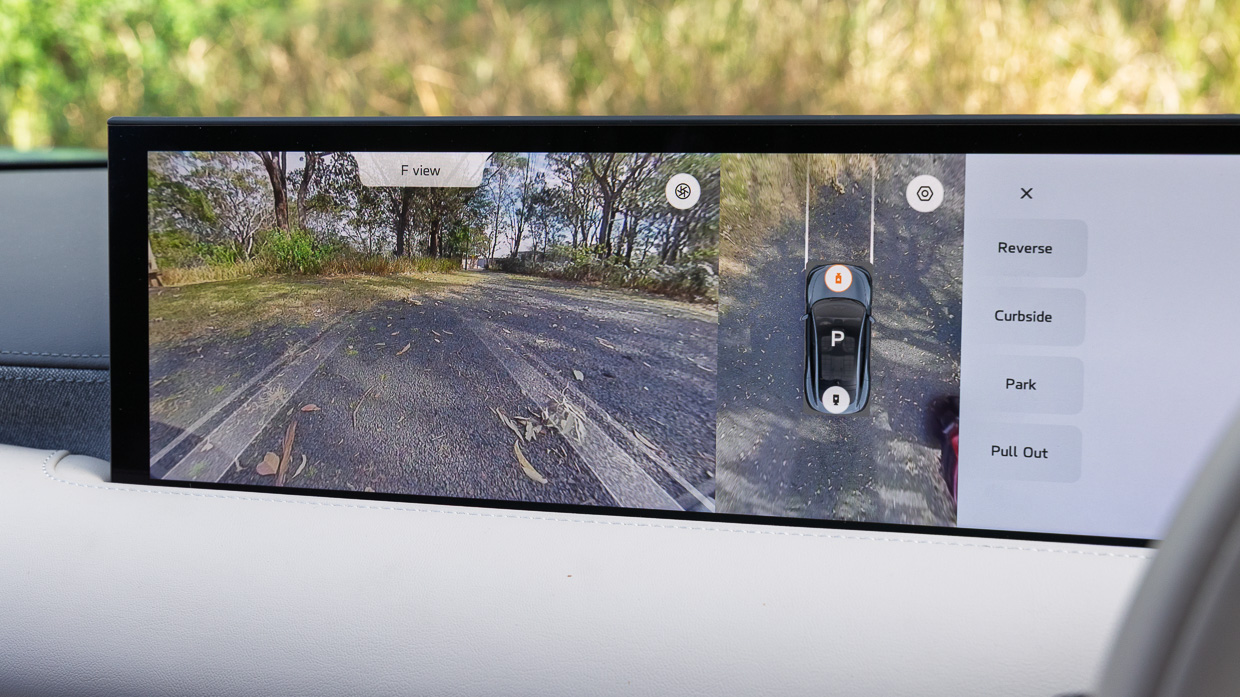
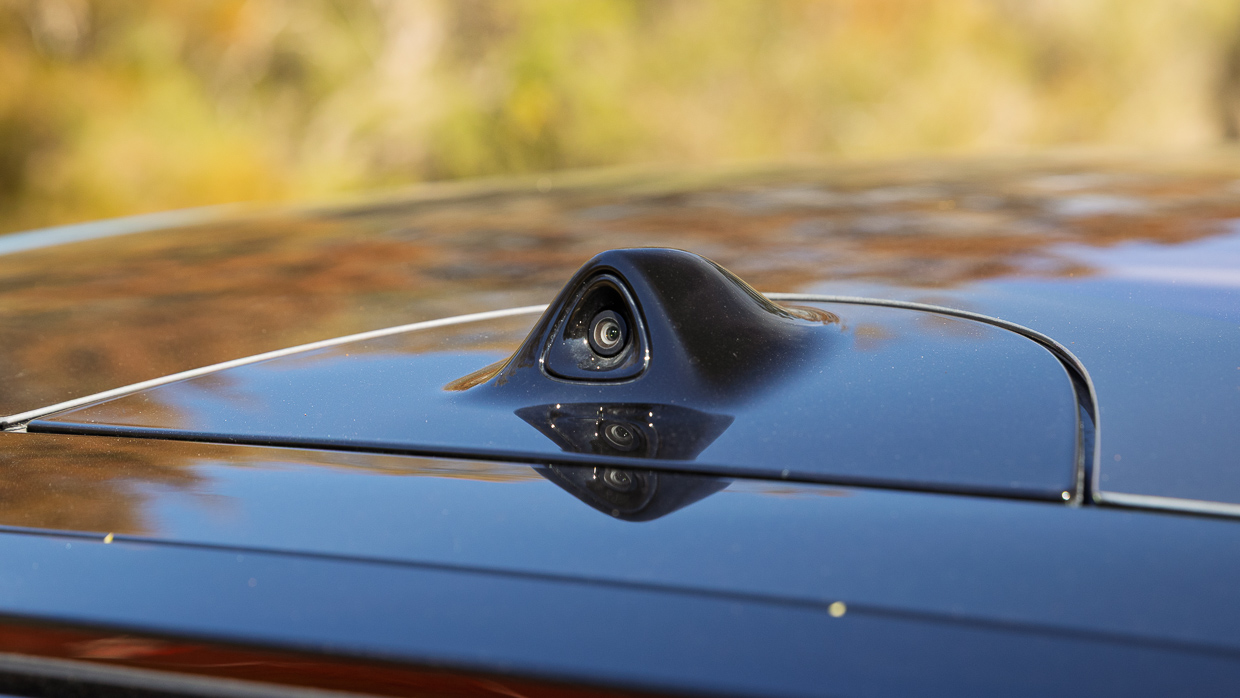
There is pretty much every conceivable active driver aid you can name on the standard-equipment list for every grade, and all IM6 models feature nine high-definition exterior cameras and a dozen ultrasonic sensors.
What are the IM6 Performance’s ownership costs?
The IM6 Performance requires servicing every 12 months or 20,000 kilometres, whichever comes first. First, third and fifth visits are $323 with the second visit $501 – but, yikes, servicing interval four is an eye-watering $1459. Total five-year/100,000km outlay is $2929.
For a (five-year) comparison with Kia and BYD rivals, service-visit costs are capped at $1535 for the Kia EV5 and at $1648 for the BYD Sealion 7. A Toyota bZ4X AWD costs just $900 across the same period. (Tesla takes a more ad-hoc approach to service scheduling.)
The excessive 40-month/80,000km interval is largely down to required coolant changes and filter replacement for dual-motor electric drive units and battery hardware. The single-motor Premium drops this fourth interval down to $1294.
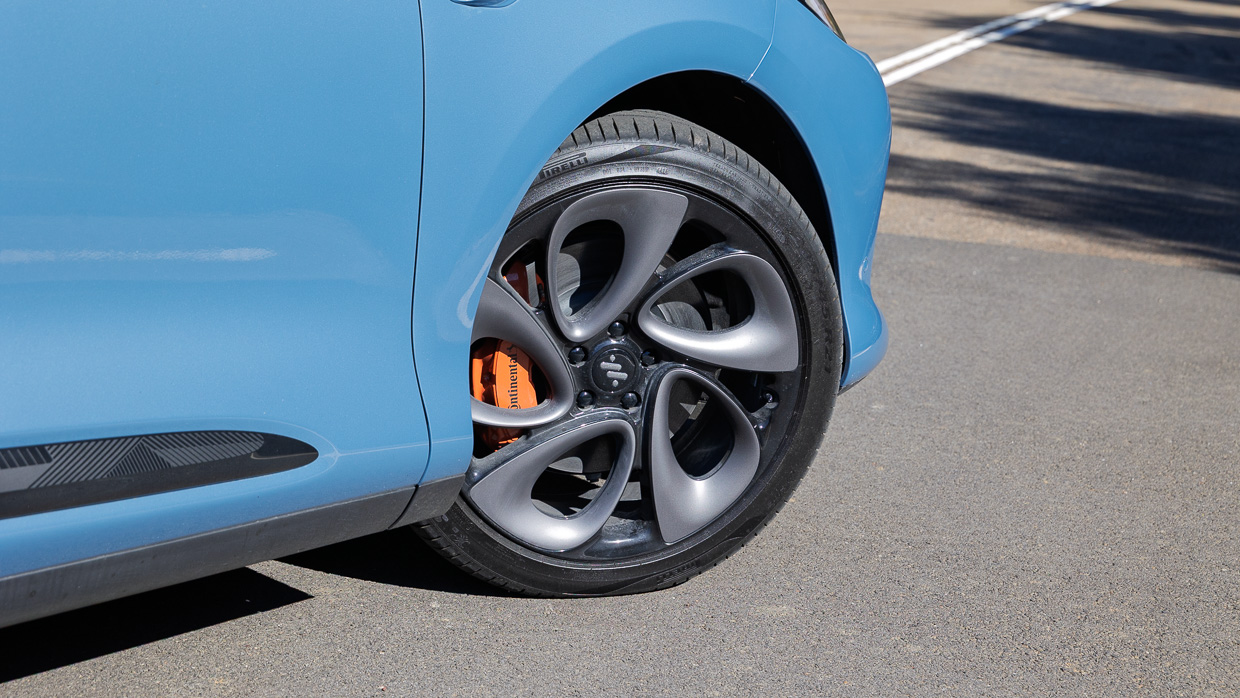
Basic warranty is five years of unlimited-kilometre warranty, extendable to seven years if serviced through the MG IM network. Meanwhile, the high-voltage battery warranty is eight years, if capped at 160,000 kilometres.
The honest verdict on the IM6 Performance
We’ve only been given this flagship IM6 Performance to sample so far (along with the better-driving IM5 sedan), and on paper the mid-range Platinum looks like it could be the sweet spot of the line-up.
It offers a longer WLTP range and is $11,000 cheaper despite matching the Performance for the majority of equipment. And, as you’ve read, the Performance’s exclusive key features – the air suspension and continuously controlled damping – don’t translate into benefits on the road.
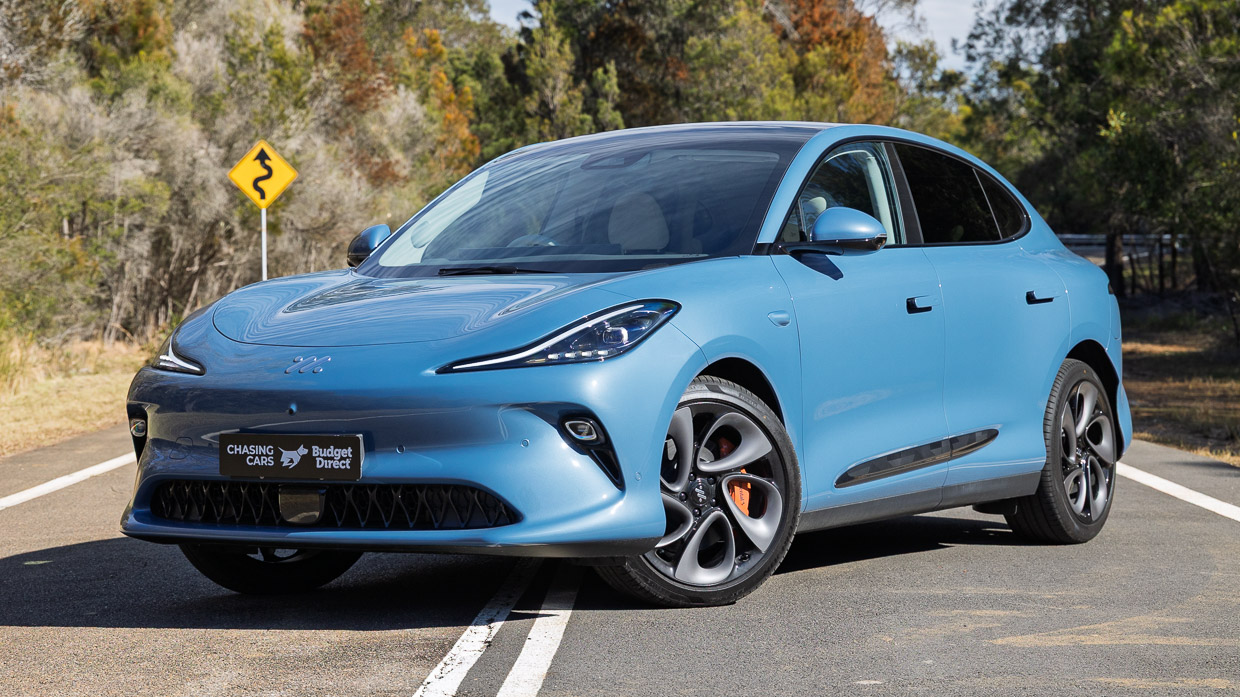
Maybe a drive of a lower-spec version will change our initial view that this new IM – or MG – SUV isn’t a Model Y beater, though these are not going to change the infuriatingly intrusive driver assistance systems, terrible rear vision, or buried vehicle functions. And, irrespective of model grade, servicing costs are high for the class, and IM models have an inferior warranty compared with regular MG vehicles.
If you’re not wedded to the high-riding body style or not too bothered about rear-seat comfort, the IM5 sedan is a much better drive.
BYD Denza B8 2026: International First Drive
2 months ago

John Law
Road Test Editor
Forget the Nissan Patrol and Toyota LandCruiser, this twin-motor monster wants to hit the Lexus LX and Range Rover where it hurts
Good points
- Stonking pace
- Leather-bound luxury
- Rear seat accommodation
Needs work
- Vague steering
- Clumsy active suspension
- Unproven tech
What do you think a four-wheel drive SUV with active suspension, 550kW, locking front and rear differentials, and 100km of electric driving range might cost?
A cool $300,000 — maybe less, maybe more. But what if you could get all those stats for less than half the price? That would be quite the offering.
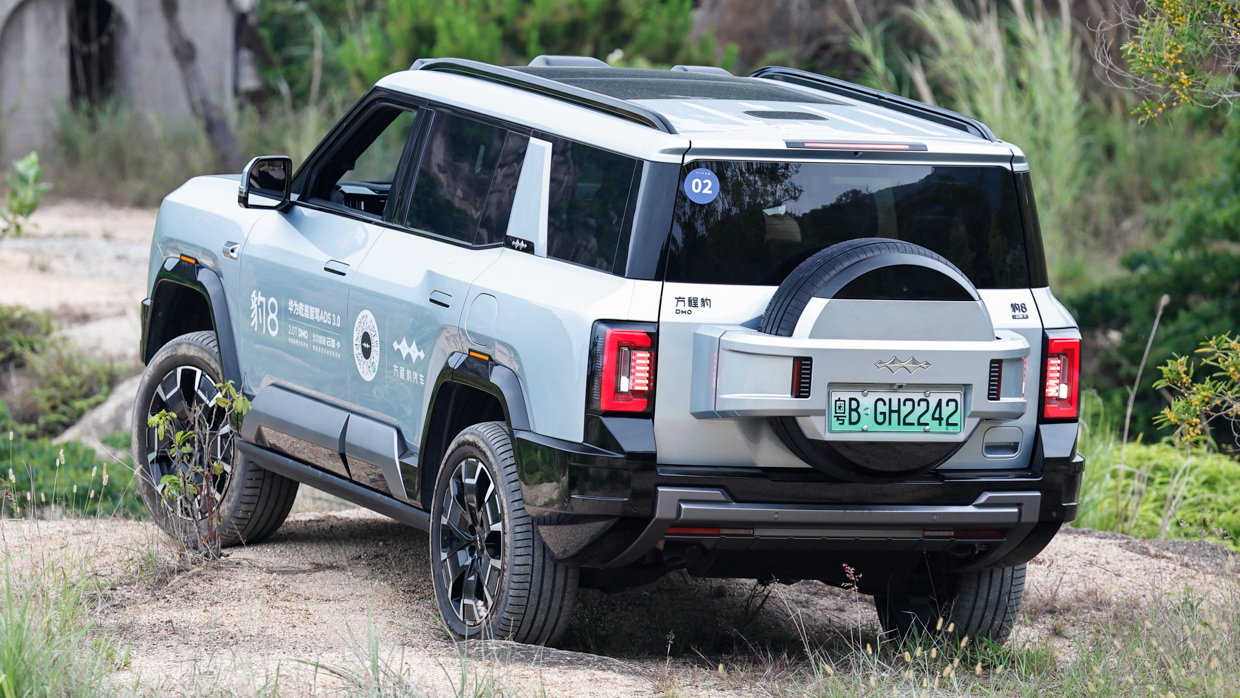
We don’t know exactly what the Denza B8 (also known as the Fangchengbao Bao 8) will cost, or even if it’s coming to Australia, but if it does the big brother to the B5 and upmarket cousin to the Shark 6 ute is touting Range Rover for tech and luxury for Toyota Land Cruiser money.
When over in China with BYD, Chasing Cars had a chance to sample various models, including the B8, which the brand is considering for Australia.
Sitting above the B5 in the China-market Fangchengbao range, the B8 uses similar ladder-frame underpinnings and DMO four-wheel drive system but with more power (up from 505kW) along with trick hydraulic suspension, and seating for seven.
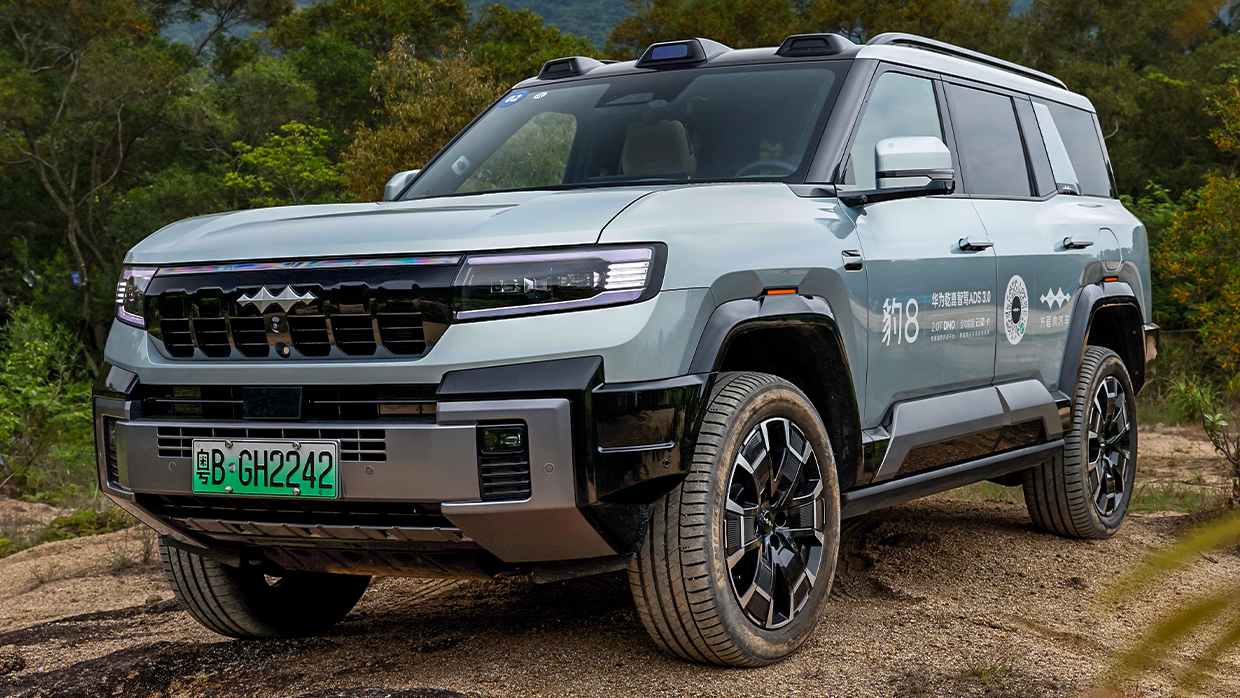
Then there’s the presence. The metallic mint example we drove is simple eyecatching, with near-vertical windows emphasised by pumped arches. Even the Defender (or maybe Santa Fe) like rear end looked good with its full-size spare hanging off the tailgate wrapped in body-colour material.
Interior accommodation feels proper luxury, too. Tan Nappa leather upholstered power-adjustable seats with heating, ventilation and massage functions ensconce you as you drop in. That same upholstery extends to the dash and door tops, along with the sturdy grab handles.
A massive 17.3-inch touchscreen sits in the middle and can be rotated between portrait and landscape orientations.
The driver gets a 12.3-inch digital display which gives information on speed, direction, and vehicle status while the passenger gets a separate touchscreen through which they can adjust audio and even run karaoke sessions.
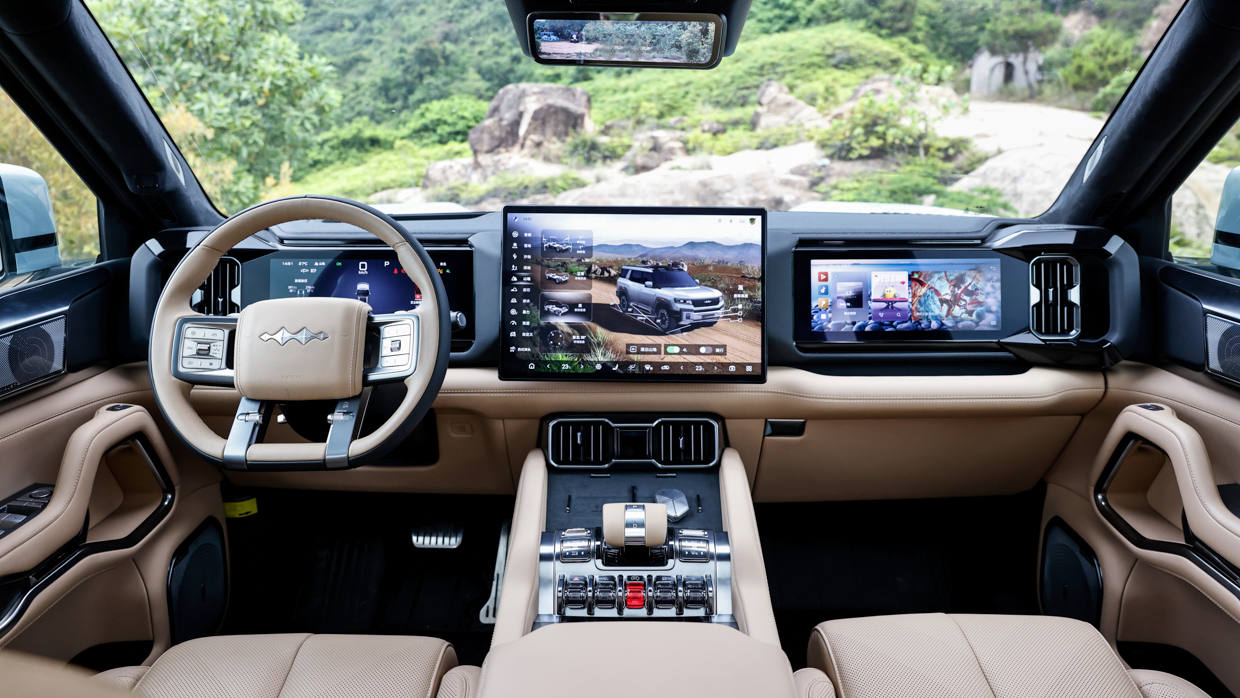
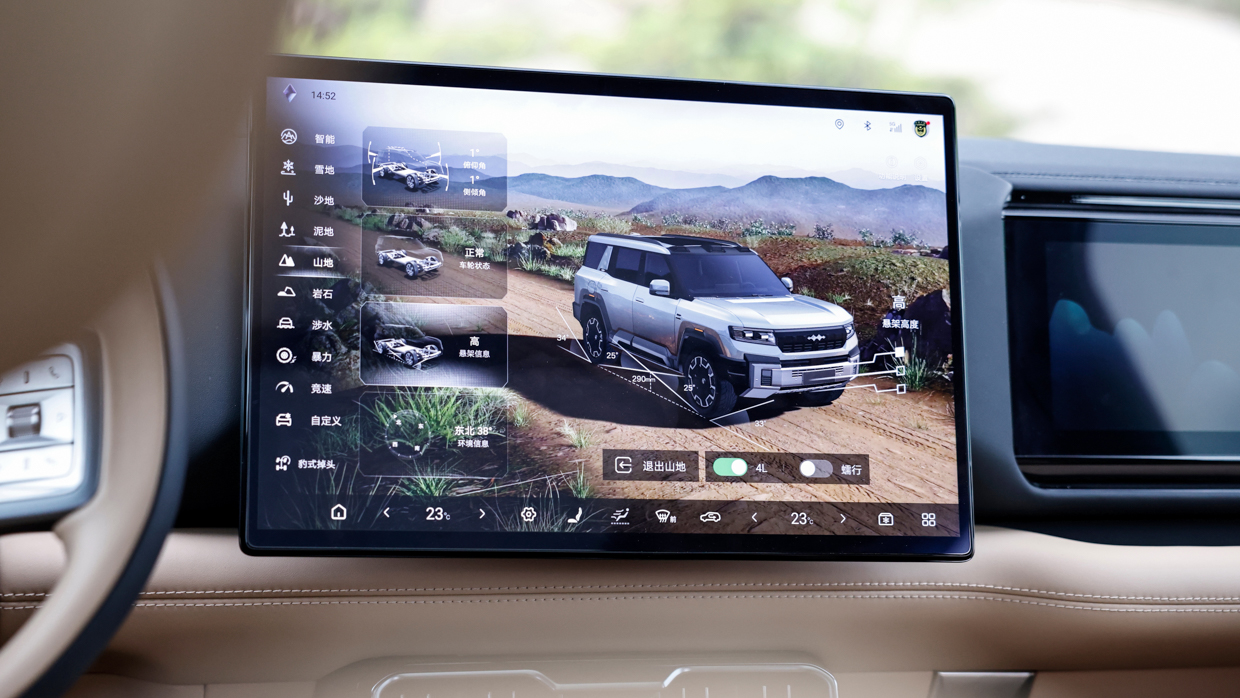
Basically, the B8 is the same, architecturally, as the B5 (and very similar to the Shark 6 ute) underneath the layer of luxury. That means sturdy construction and a smattering of useful hard buttons for drive modes, differential locks, and a volume scroll wheel. There are twin wireless charging pads in the front, too.
Second row accommodation continues in a similar vein with lashings of leather and classy brightwork giving an upmarket vibe to the cabin. There is lots of space on offer in the back with power-adjustable tilt and slide for passengers and 60:40 split seating.
Touchscreens control two separate temperature zones and volume in the back, there’s heated and ventilated seats, a huge panoramic sunroof, Isofix tabs, leather-bound grab handles and power open doors with soft-close function.
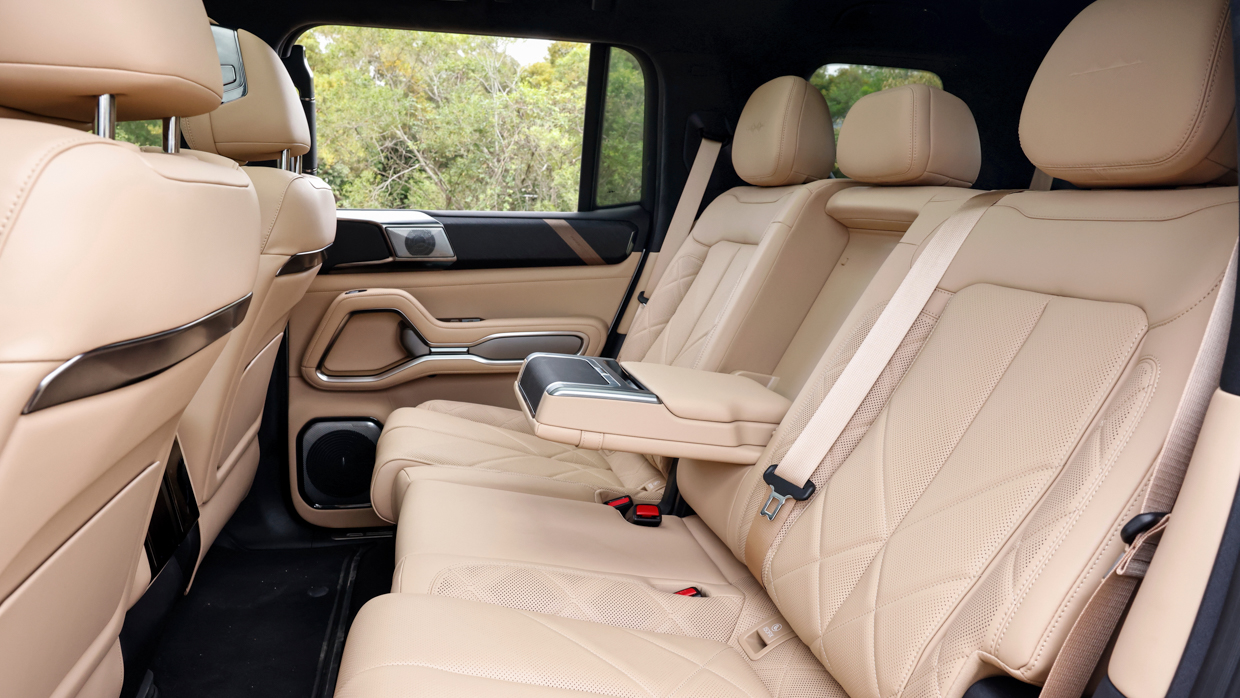
Unlike the shorter B5, the 5.2-metre long B8 manages to squeeze in a third row, too, with power-folding seats for ease-of-use.
The boot is large and square with a side-swing tailgate. Being a 4WD, the load height is quite elevated but the pneumatic suspension can raise or lower for easier loading. A netted cubby is nestled into the fairly chunky tailgate for extra, easy-access storage when the B8 is heavily loaded.
Under the B8’s bonnet is a 2.0-litre turbo-petrol four-cylinder putting out 200kW — nothing hugely special. It’s teamed up with a 36.9kWh lithium iron phosphate (LFP) battery pack from which a pair of electric motors draw power.
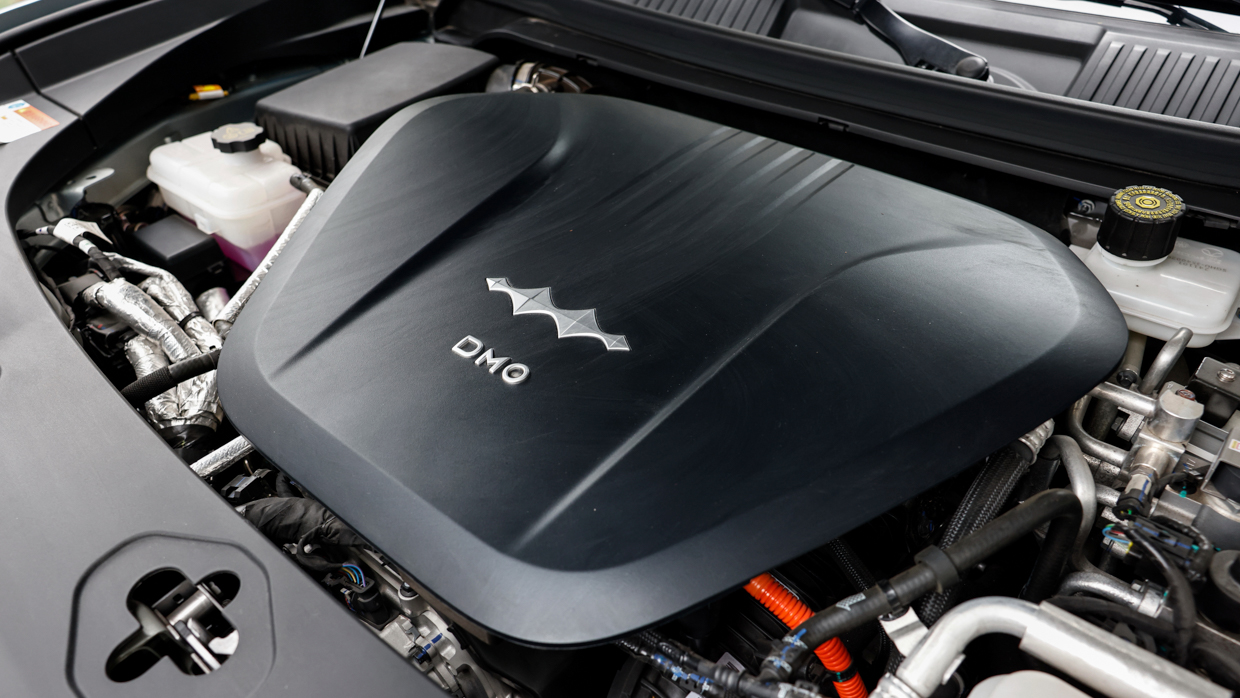
Total combined outputs are a staggering 550kW and 760Nm — yikes. An equally planetary 3305kg kerb weight does stunt the B8’s pace somewhat, though 0-100km/h in 4.8 seconds is pretty bloomin’ rapid. Top speed is limited to 180km/h.
Solid EV credentials include 100km of CLTC-verified electric-only range, fast-charging up to 120kW (DC) and 1200km claimed combined driving range.
Three pods on the roof look a little robotaxi, yet house more smarts with 12 cameras, 12 ultrasonic sensors, three millimetre-wave radars and a Lidar sensor promising level 2 autonomy with urban self-driving — though we didn’t get to sample these features.
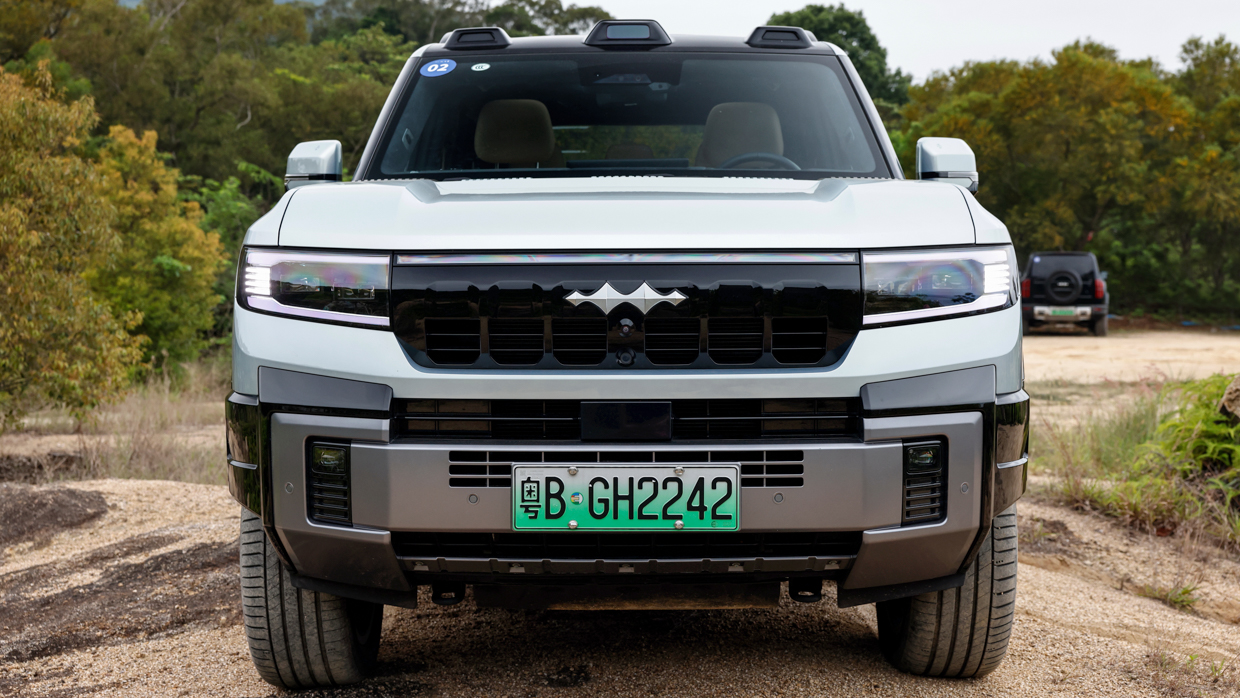
We’ll start the drive impressions on dirt, where a claustrophobic ATV track emphasised the B8’s near two-metre width as much as the light electric power-assisted steering system. It features a simulated low-range setting which gives more measured power delivery. There are myriad drive modes, including the intriguing ‘Burst’ mode to get the vehicle un-stuck.
We didn’t have to use that one, thankfully, though there was an obstacle to play with the electric locking differentials, which are easily engaged with a physical switch near the gear selector, or through the touchscreen. With easy-to-modulate e-motors and plenty of ground clearance, the B8 showed potential off-road.
The B8 rides on active, hydraulic height-adjustable suspension BYD calls ‘DiSus-P’ allowing the B8 an impressive 890mm maximum wading depth and up to 310mm ground clearance. We noted that, oddly, the more complex B8’s ride was busier on dirt and on tarmac than the steel-sprung B5.
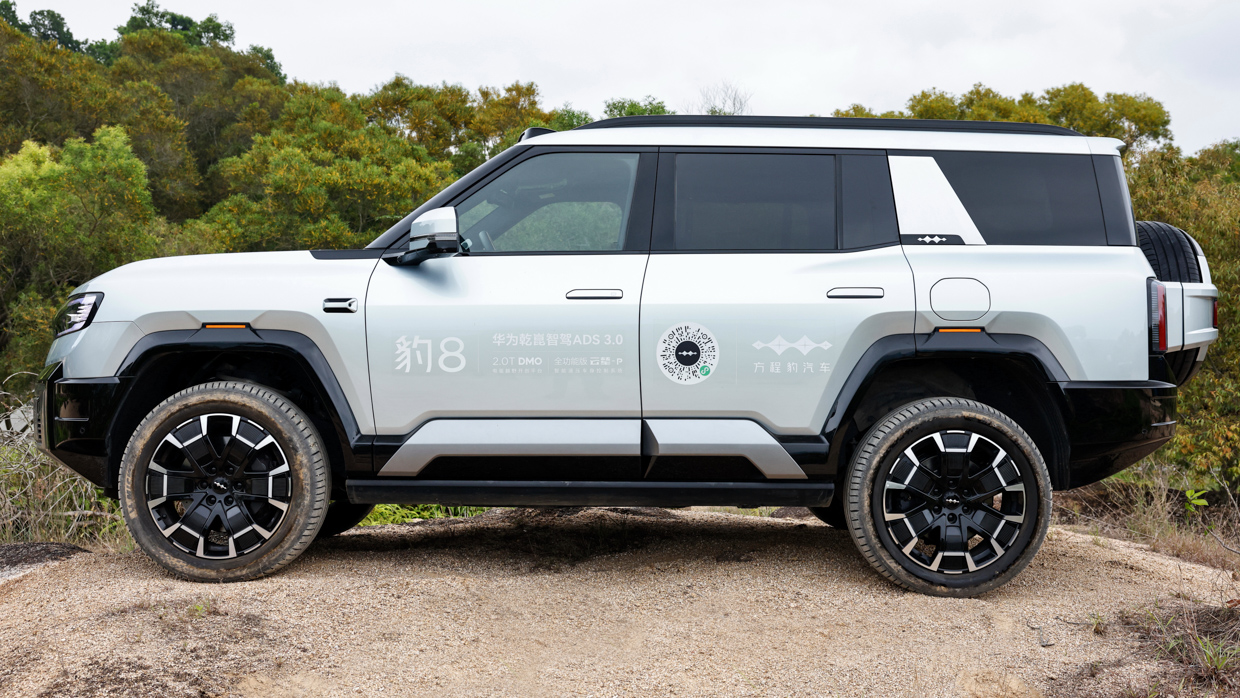
A car-park test drive in the B8 revealed stonking straight-line acceleration. It still rears up under power, but the trick suspension tries its best to counteract physics and so the B8 feels a bit more in control than the B5. Through the corners, this is true to an extent though the larger Bao is still quite a handful.
Not quite as wayward as the even more complex, quad-motor Yangwang U8 that was also circulating. So while BYD seems to have all the technology in place, truth is the B5 was the most pleasant and cohesive of the three 4WD models to pilot. There’s room for improvement in the B8’s smart systems, for sure.
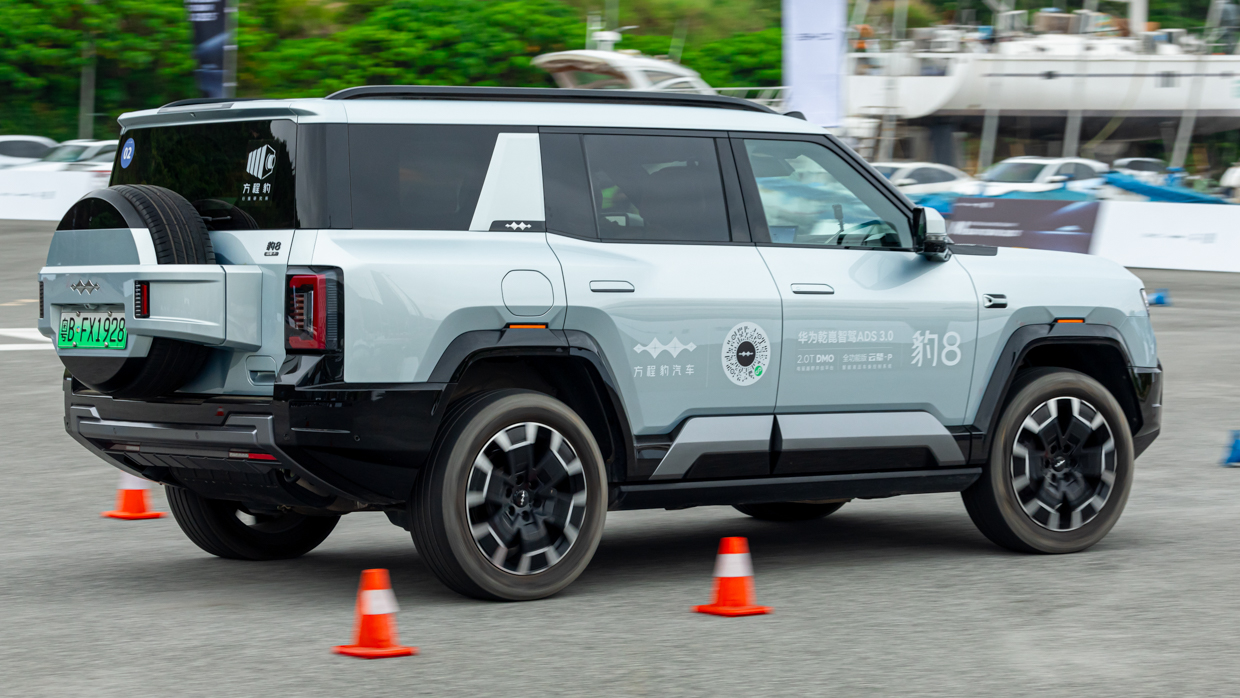
Should BYD consider this Lexus LX and Nissan Patrol challenger, then? Well, at under $100K, the B5 is a no-brainer to take on Prado, Everest, GWM Tank and co, but the B8 is harder to swing.
With a vehicle like the B8, BYD’s luxury Denza brand would be truly playing up into the luxury territory where badge credence counts for a lot, and in Australia reliability and parts availability counts for even more.
Haval H6 Ultra Hybrid 2025 review
2 months ago

With a plugless hybrid system and improved looks, GWM’s Haval H6 Ultra HEV seems to make sense – but is now the right time to buy?
Good points
- Pleasantly updated styling
- Facelift’s $2000 price reduction
- Smarter dashboard design
- Efficient on the highway
- Very roomy back seat
- Decent safety system tuning
Needs work
- Laggy acceleration off the line
- Jerky petrol/hybrid partnership
- Disappointing urban fuel economy
- Surprisingly limited tyre grip
- Overly stiff ride quality
- Uncomfortable front seats
While the mantra of “moving fast and breaking things” appears to have been the unspoken strategy of many of its Chinese carmaking peers, GWM — the conglomerate behind sub-brands Haval, Cannon, Tank and Ora — has acted more like a traditional brand.
Since launching with a series of pretty forgettable utes in 2009, GWM has slowly iterated and improved its product and enjoyed a gradual uptick in sales success over the years. Chasing Cars has called out problems with GWM cars and seen the manufacturer respond, its fixes being of mixed success.
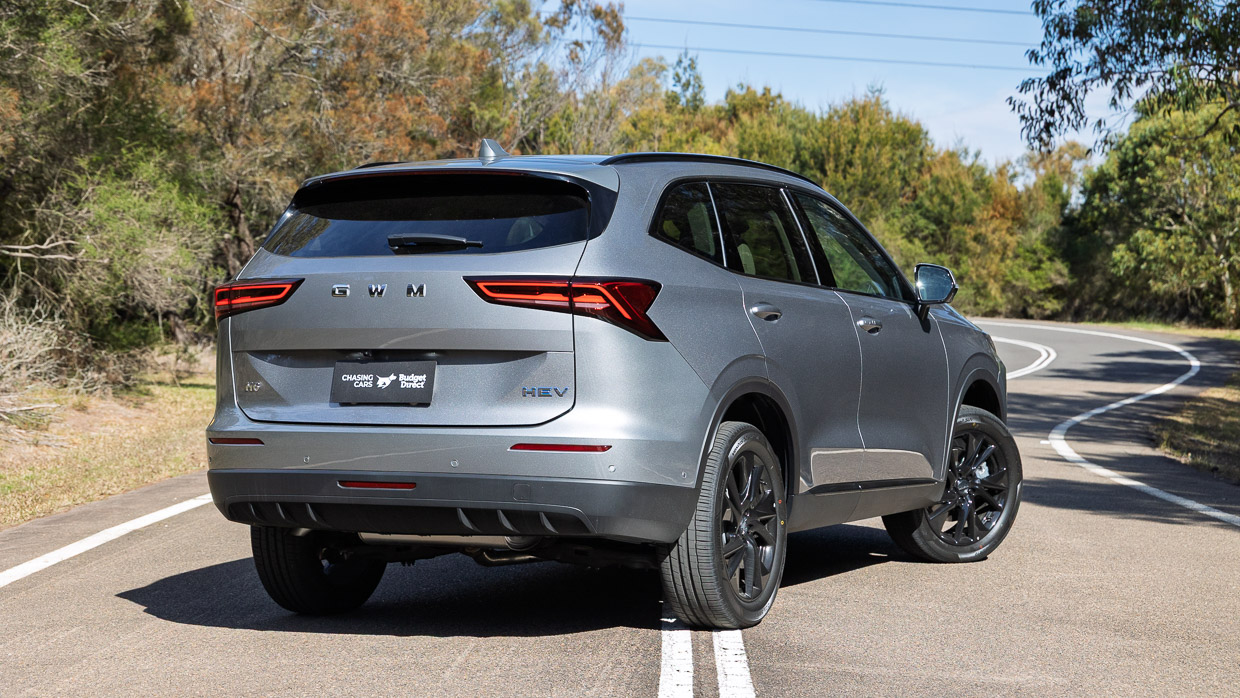
Now, though, flush with new executive talent poached from rivals, GWM wants to turbocharge that growth and become a top-five brand locally. That will require its utes (including the Cannon Alpha PHEV) to do big business; most important, though, is getting a midsize SUV right.
While GWM has a few medium crossovers in its expanding lineup, the most important is the Haval H6. At 4.7 metres in length, this is a pretty classic ‘Toyota RAV4 on a budget’ sort of vehicle. H6 is a two-row, family-sized plugless hybrid that rides high.
Except that it’s more than 20 percent cheaper than the Toyota, like for like, and very generous on specification. And next month it’ll also be available as a plug-in hybrid with nearly 100km range; and there’s still a non-hybrid option on offer, too.
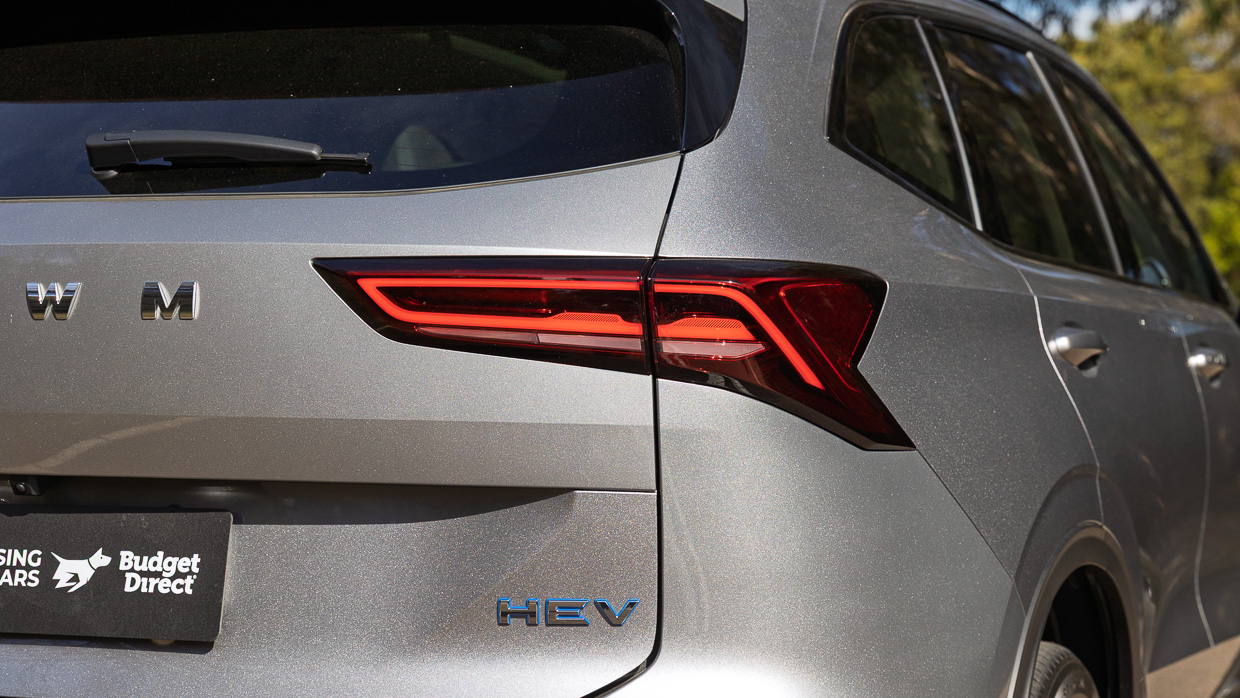
We’ve tested the H6 a number of times in third-generation form and have generally found it to be spacious and competent enough – but cheap inside and mediocre to drive.
This year marks a major late-in-life facelift for the gen-three H6. Banished are the acres of exterior plastichrome in favour of a more mature aesthetic; the cheapest base grade is gone, replaced with a clearer two-tier Lux/Ultra lineup with a tonne of specification.
But the mechanical package essentially carries over… for now. GWM has made a meaningful hire in Australia in picking up Rob Trubiani, an ex-General Motors chassis guru who contributed to the great-to-drive VE/VF Commodore effort.
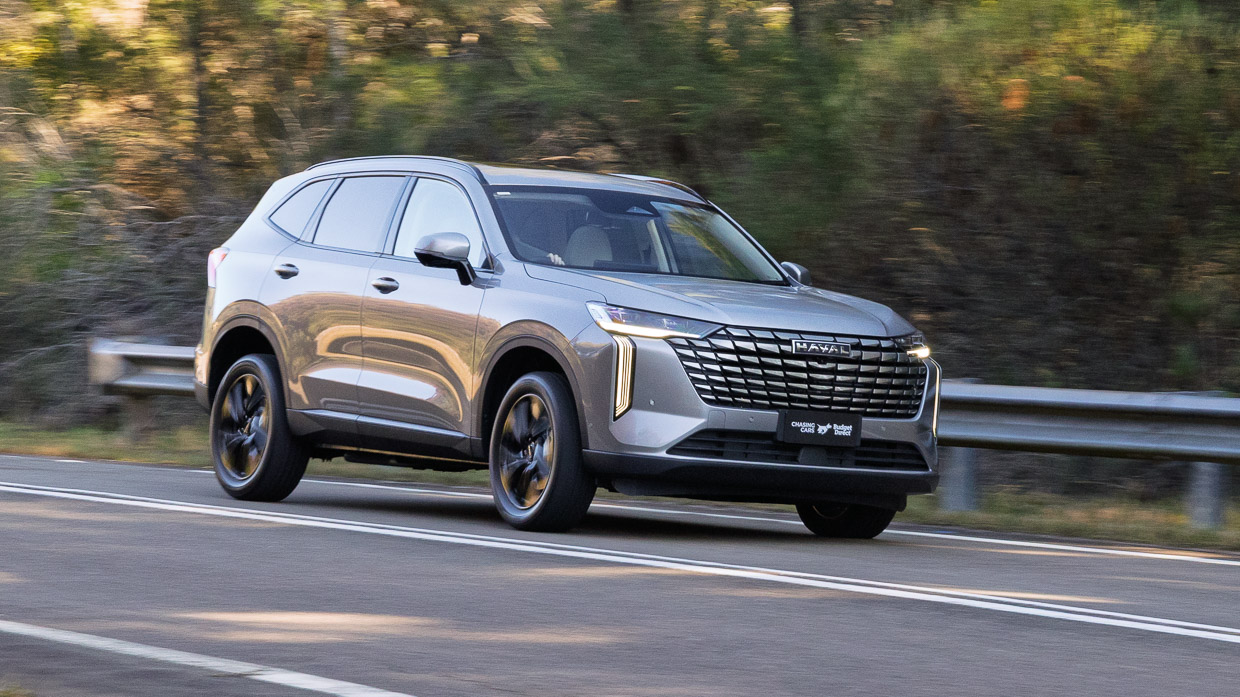
Trubiani has, we’re told, been given good access to changing the ride and handling of key GWM models like the H6 – but his changes haven’t come down the production pipeline yet.
So is now the right time to buy a freshly facelifted Haval H6? Let’s investigate.
What are the H6 Ultra Hybrid’s features and options for the price?
There are two vehicles in Australia that wear the Haval H6 badge. The first is this facelifted, conventionally ‘wagon-bodied’ SUV measuring 4703mm long, 1886mm wide and 1730mm high on a 2738mm wheelbase.
The second Haval H6 is the H6 GT – it hasn’t been facelifted yet, and it wears more rakish coupe-like styling. Also of note is that Haval will soon launch an SUV called the H7, which is an H6 underneath with far boxier styling on top for those that prefer square lines.
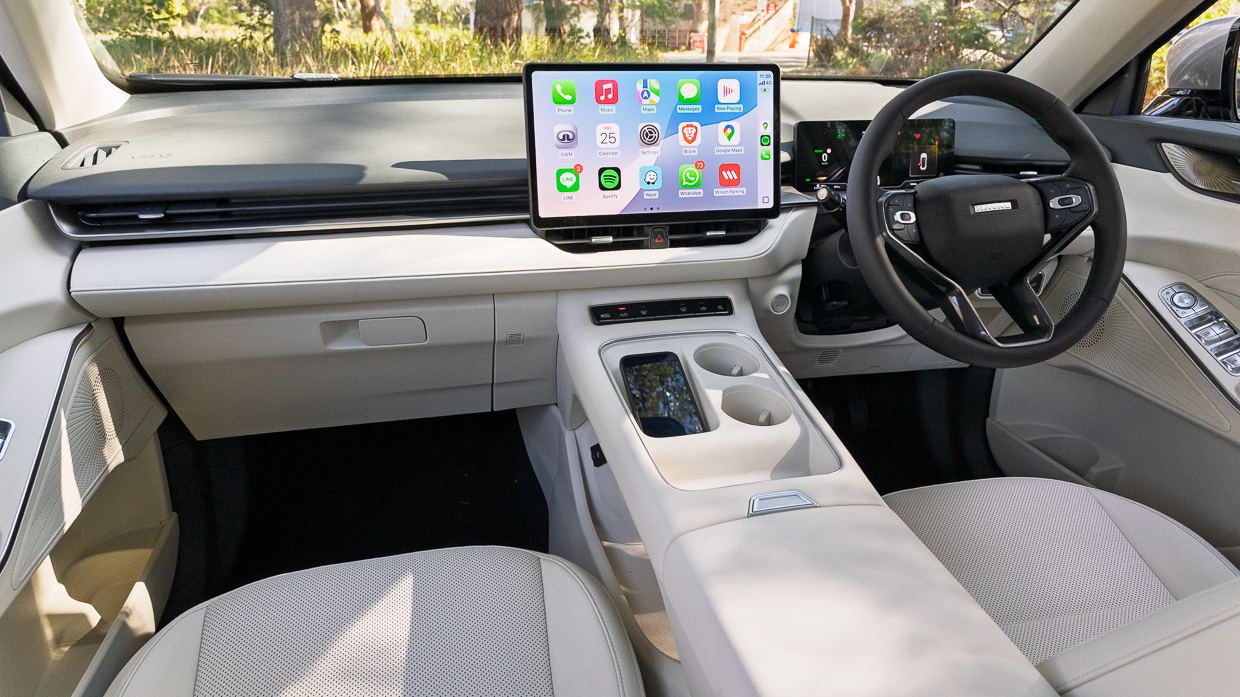
Beyond the inside-and-out facelift, the biggest change to the H6’s value proposition this year is the deletion of the Premium base model which previously opened with petrol power at $33,990 driveaway – that’s very cheap for a midsize SUV these days.
With extensive visual changes, the updated H6 now kicks off $2000 higher with the H6 Lux, priced at $35,990 (d/a) with a 170kW/380Nm 2.0-litre turbo petrol four-cylinder engine (ICE) or $40,990 (d/a) with a 179kW/530Nm 1.5-litre turbo plugless hybrid (HEV) – both of which are front-wheel drive.
Lux moves a little upmarket in facelift form, adding larger 19-inch alloys (now in black), a big 14.6-inch touchscreen with wireless Apple CarPlay/Android Auto, six-way power driver’s seat, tilt/telescoping adjustments for the steering wheel, and auto-folding mirrors.
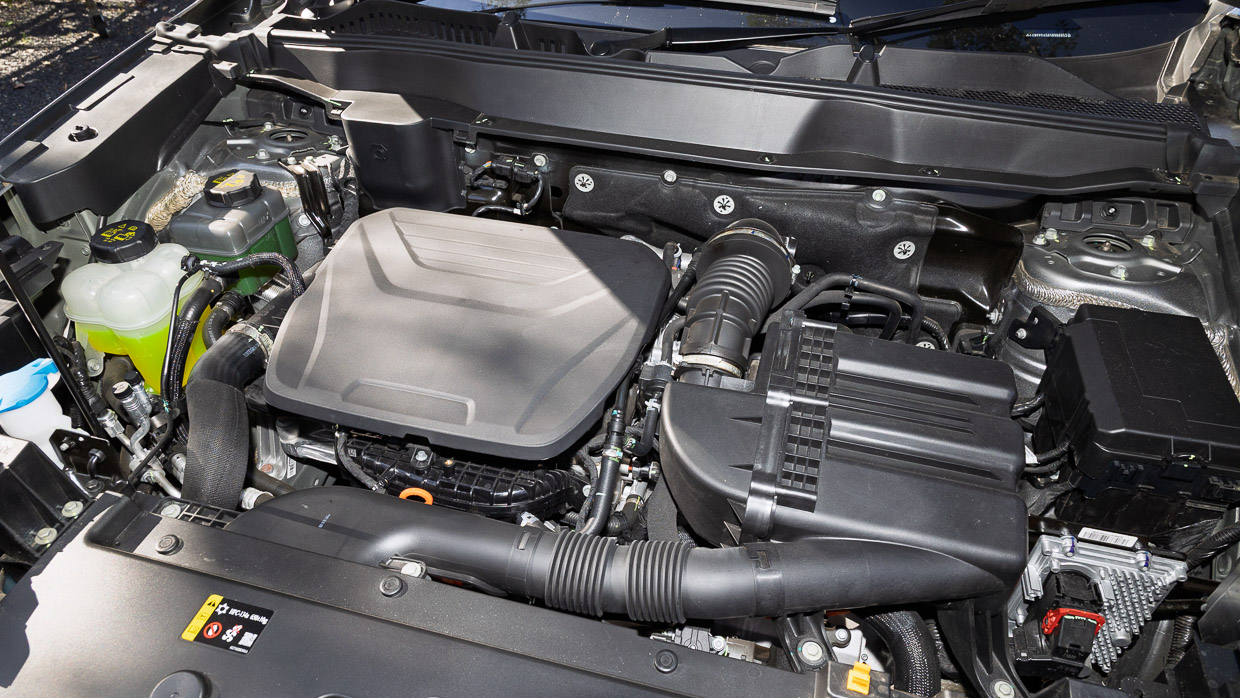
Other Lux spec continues on, including auto LED headlights, 360-degree camera, fake leather, a 10.25-inch digital instrument cluster, eight-speaker stereo, 50-watt wireless charger, keyless entry, four USB ports and tyre pressure monitoring.
Our test vehicle was the higher of the two trim grades – the H6 Ultra, which kicks off at $38,990 (d/a) for the ICE powertrain and $43,990 (d/a) for the HEV. This grade of H6 actually saw a $2000 price reduction in facelift form.
Unlike Lux, Ultra trim can also be specified with plug-in hybrid (PHEV) power: a 240kW/540Nm front-wheel drive version, or a 268kW/760Nm AWD from GWM’s newer Hi4 series of PHEVs – the latter promising a blistering 4.8 second 0-100km/h time.
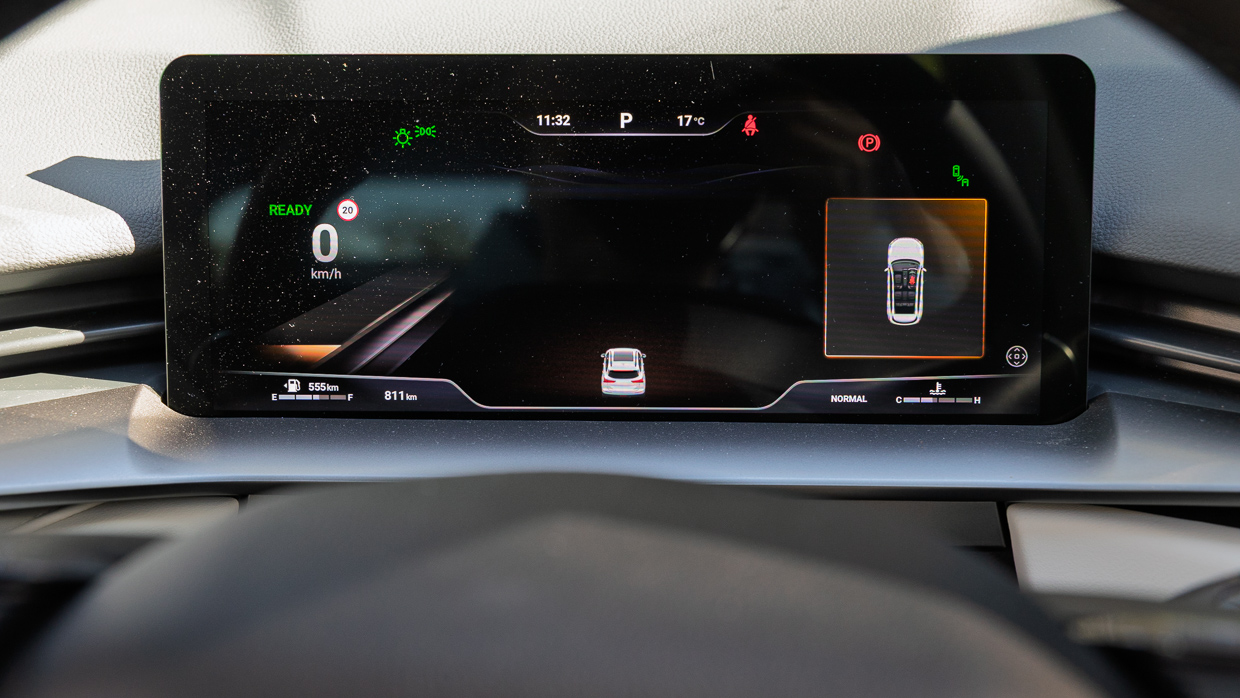
Atop Lux, Ultra adds privacy glass, an opening panoramic sunroof, heated and cooled front seats, a heated steering wheel, memory and lumbar adjustment for the driver’s seat, heads-up display, automated parking, and front parking sensors.
The only options relate to colour. Hamilton White is no-cost, while Astral Pearl, Ayers Grey and Golden Black each attract a $495 premium. The internal Comfort Tek upholstery is black by default though a cooler-for-summer cream hue is no-cost on Ultra.
How does the H6 Ultra Hybrid drive?
How the H6 drives is a story of three distinct engine types: non-hybrid, plugless hybrid, and PHEV. Performance ticks up at every step while fuel economy gets better – though more speed is only a good thing if a car’s chassis and tyres can handle more pace.
We’ve tested the ICE and HEV versions of the H6 in the past and their mechanicals carry over. The twin PHEVs are the new addition for the regular-shape H6, and we’ll be testing the plugged versions soon – especially the new Hi4 AWD plug-in with its ultra-rapid acceleration claim.
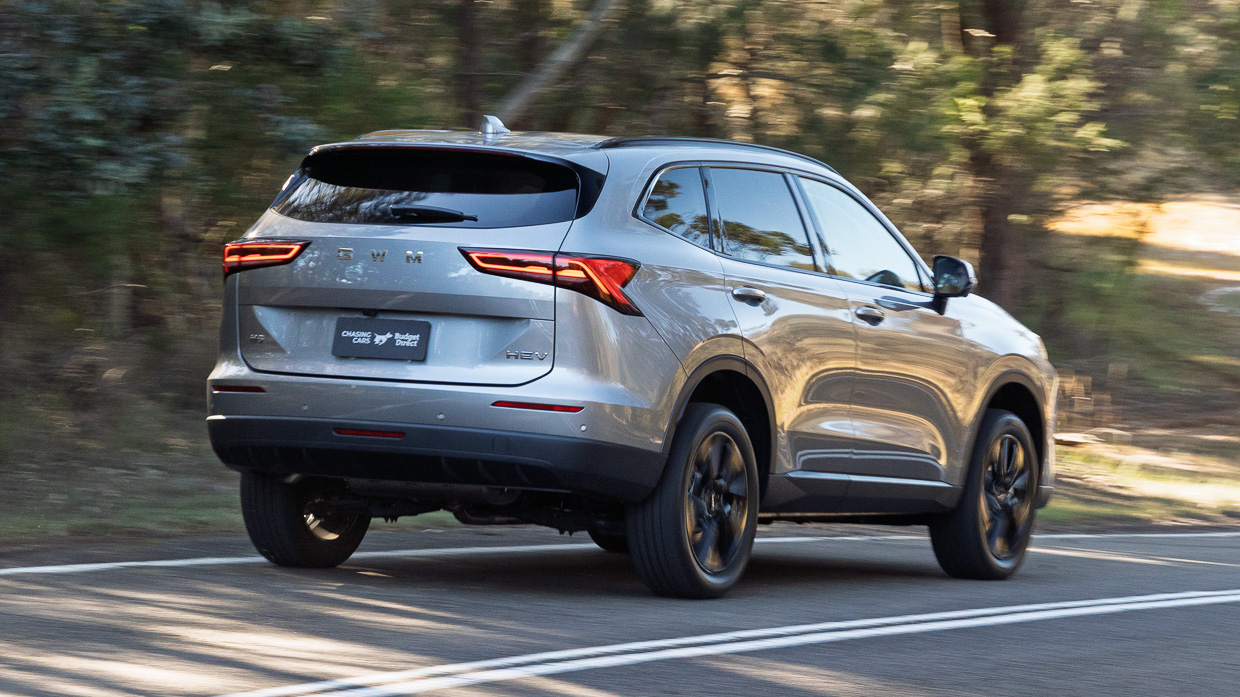
The non-hybrid petrols haven’t arrived in facelift form so our test was entirely limited to the Ultra HEV, which combines a 1.5-litre turbocharged petrol ‘four (110kW/230Nm) to a front electric motor and hybrid transmission (130kW/300Nm).
Combined outputs look pretty lush at 179kW/530Nm. GWM’s policy is quite different here to Toyota, for instance, which states the RAV4 makes 160kW (in front-drive form) but does not provide a combined torque figure.
That might be for a good reason, because while the H6 HEV looks powerful, the amount of performance it is willing and able to dole out really depends on the stars aligning – you need sufficient charge in the hybrid battery, the petrol engine to be at the correct revs and the hybrid power unit (HPU) to play along.
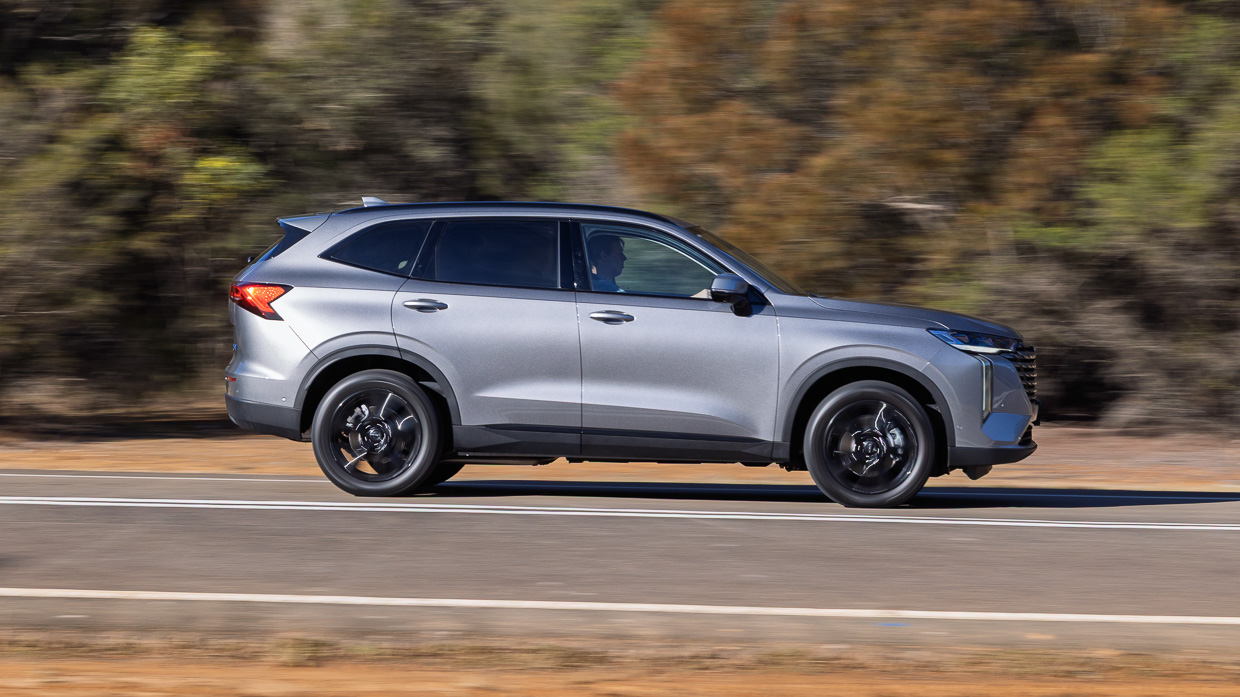
On our test, the stars didn’t often align and the HEV powertrain lacked resolve. Accelerating and turning away from a junction, demanding about 50 percent throttle, we were repeatedly caught out by the HPU hesitating for seconds at a time about whether to wake the petrol engine up – the H6 just sitting there, engine revving, going nowhere.
Adding insult to injury is the fact that, once the control units do finally work out how much petrol and electric power to combine, the torque that arrives overwhelms the surprisingly limited grip of the front tyres, which then attempt to lay a burnout past pedestrians.
This doesn’t mean the core powertrain is bad. It’s all in the software tuning – this can be solved. We just wish it had been solved to accompany the relatively handsome facelift.
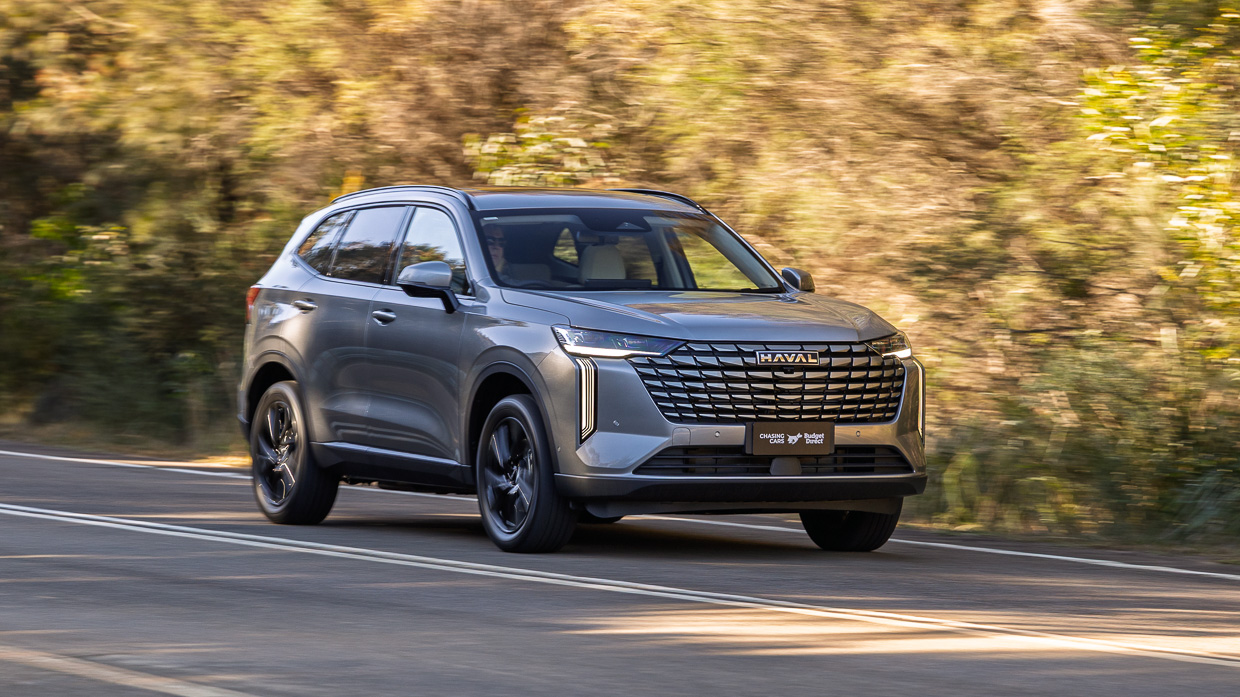
Sometimes, the HEV powertrain just works. Rolling acceleration (such as from 60km/h to 100km/h) is excellent – the turbo petrol’s muscular performance conjoining to available electric power to accelerate very promptly and quietly. When the HEV system works, it works well!
We suspect that the ICE version is simpler and crisper (albeit thirstier). Maybe the PHEV will be the combination that feels smoothest in the H6; we’ll see.
The reason we’re tentative about whether now is the right time to buy an H6 comes down to the ride and handling, which we know GWM, and ex-GM, engineer Rob Trubiani is likely to alter significantly over time – though his changes haven’t been seen yet.
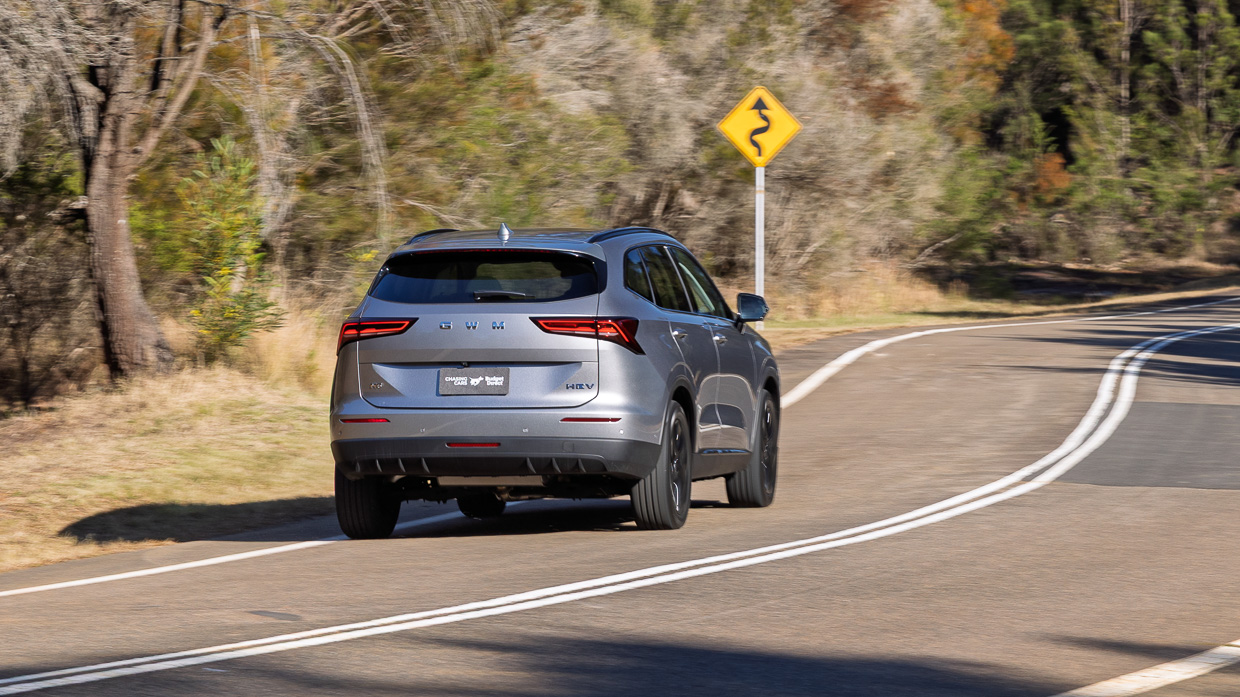
Frankly, the H6 isn’t terrible to drive, though it does trail the intuitive, pleasant dynamics of the segment-leading Toyota RAV4. It also trails ‘middle of the road’ SUVs like the Hyundai Tucson/Kia Sportage for consistency of control surfaces, ride quality, and handling ability.
Relatively loose steering, a tendency to understeer (multiplied by oddly poor traction on the Hankook tyres) and some rack rattle when hitting mid-corner bumps reveal plenty of work for Mr Trubiani.
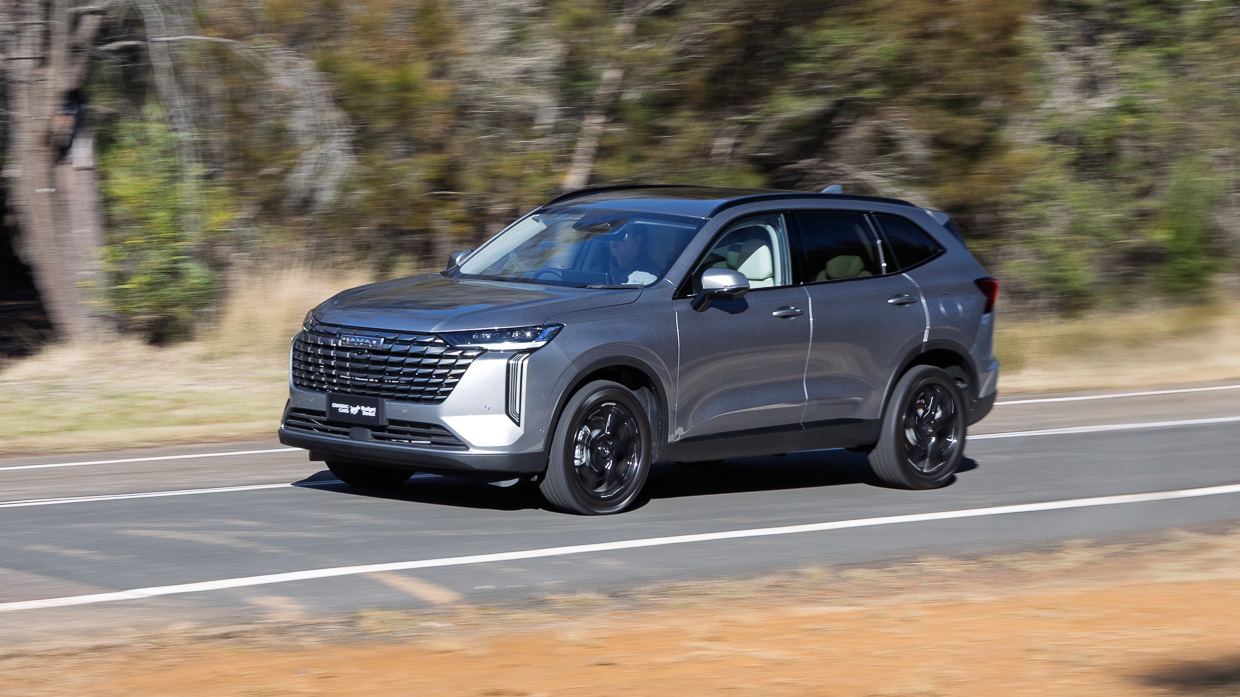
The suspension isn’t too bad, with reasonable body control from the spring/damper rates keeping the body level after hitting speed bumps, but the inherent ride quality is firm and at times a touch harsh. The big 19-inch wheels wouldn’t be helping in that regard.
Whether Trubiani will be able to catapult the H6 from the bottom half of the segment (on driving dynamics terms) to the top half remains to be seen – but having witnessed his work at Holden we’d be waiting to find out.
What is the H6 Ultra Hybrid’s interior and tech like?
With the facelift of the H6, GWM has made more changes than usual to the structure of this SUV’s cabin. While the top part of the dashboard shape has been retained, a new central bridge design sees the transmission selector relocated to the column, while a lot of new storage has been added in its place.
Our tester’s cream Comfort Tek interior was ultra-bright, multiplying the feeling of airiness, but there’s no way to avoid it: the H6 is very spacious inside, with heaps of room to stretch out for front and especially rear seat passengers.
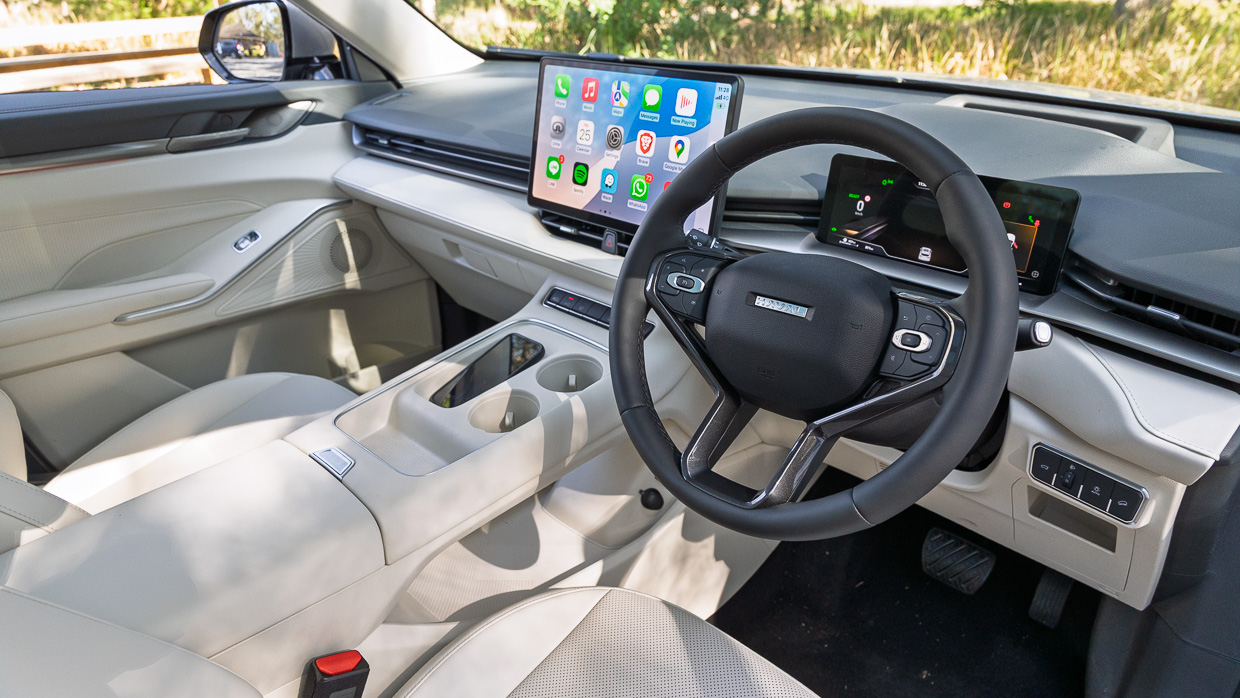
The affordable pricing of the H6 should give away that this isn’t a luxury car, though GWM has done a reasonable job coating the interior in a ‘veneer’ of premium materials – almost literally, with a soft, vaguely gummy surface covering the new bridge to stop phones and coins sliding about.
Sadly, the front seat shaping carries over from the pre-facelift H6. For our body type, the pews are not comfortable, particularly due to a lack of under-thigh angle adjustment meaning our legs go unsupported while driving. Try this yourself to see if you’re in the same boat.
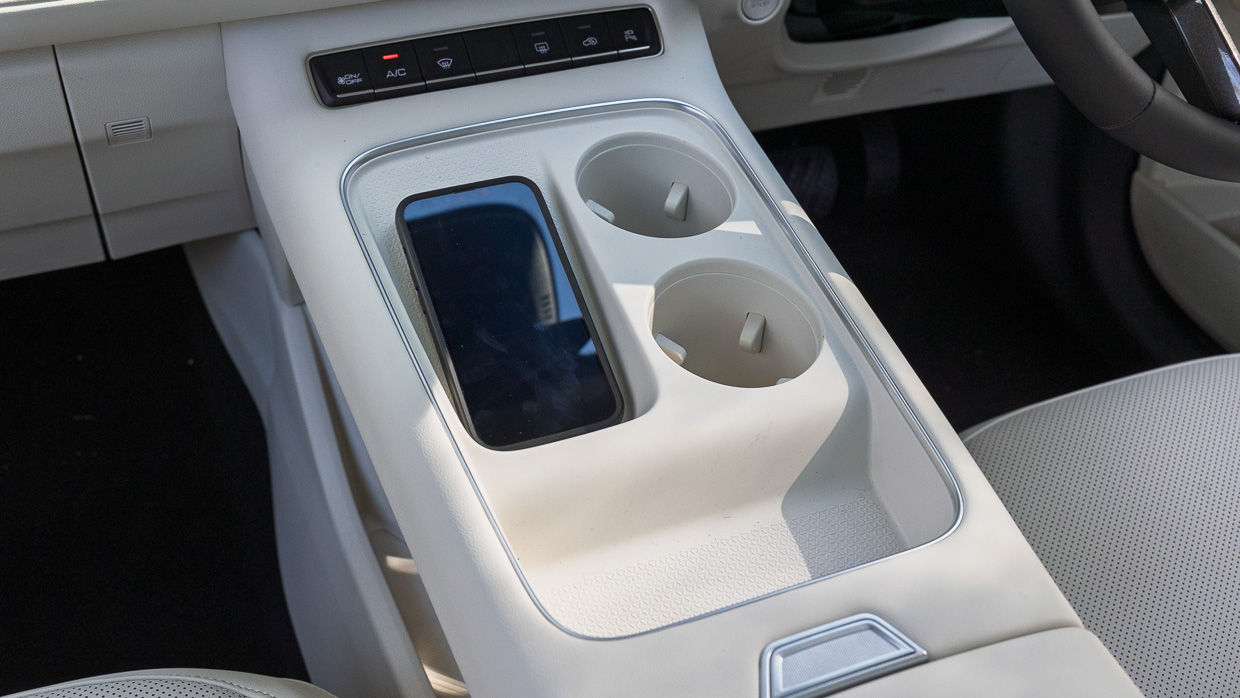
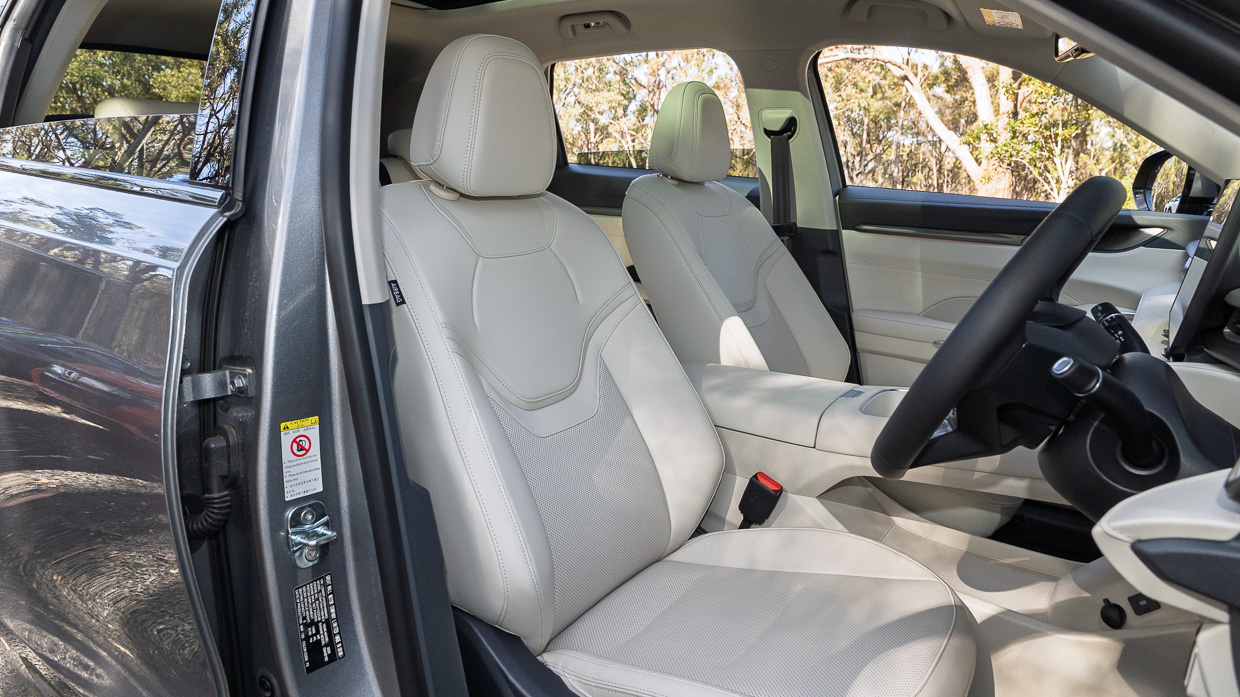
Comfort Tek is artificial leather that induces sweat in summer – at least it did when black was the only interior colour option. Not only will the white alternative help, the Ultra also benefits from surprisingly forceful cooled seats (they’re also heated).
The steering wheel is heated too, and its rim is now thicker. An oddity is that the PHEV actually has a different wheel, because its infotainment system is a generation newer than the other H6 powertrains, packing with it connected car tech like remote locking and climate control.
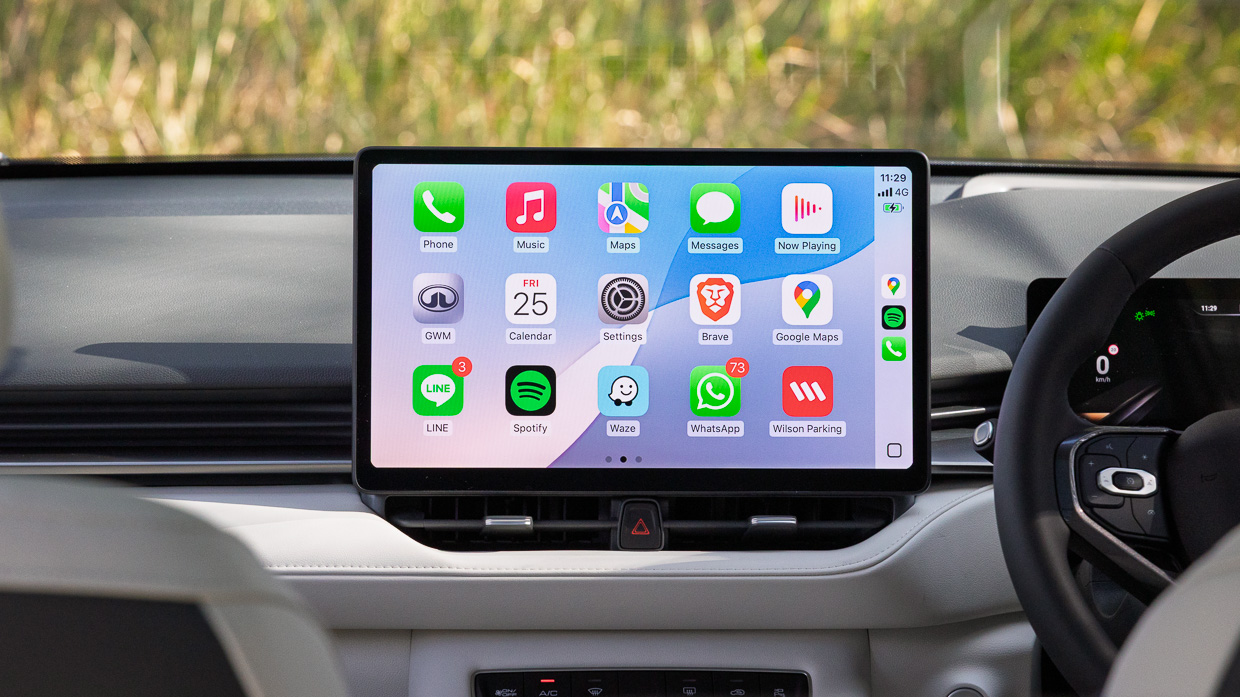
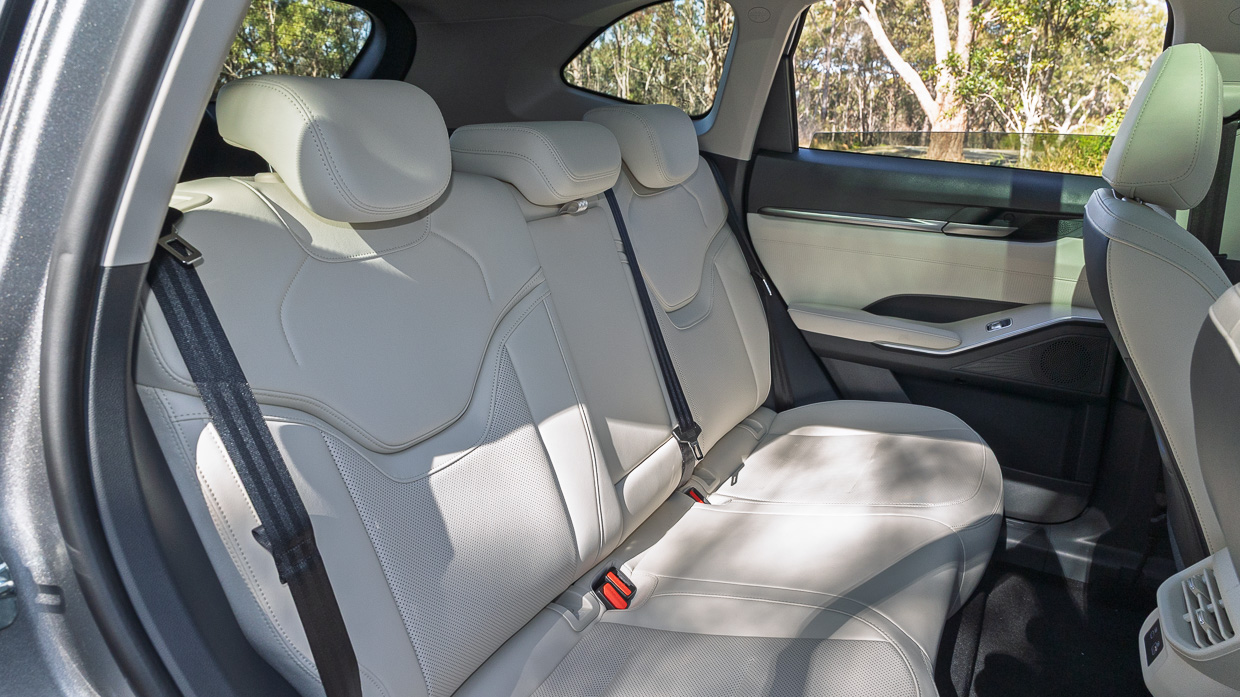
Those conveniences are missed on the ICE and HEV versions (potentially forgiveable, based on the fair pricing), though all H6s do pick up a circa-40 percent larger 14.6-inch central touchscreen that is very bright (too much so at night), snappy and crisp. Our wireless phone mirroring connection was faultless.
Despite multiple attempts, we couldn’t dial in the eight-speaker stereo to sound anywhere near clear or crisp enough to render our music well. The ICE and PHEV pick up an additional speaker. Will this help?
Back seat space is genuinely excellent, with lush legroom and, we think, more comfortable seat shaping than the front pair. Rear air vents are standard and the doors open wide.
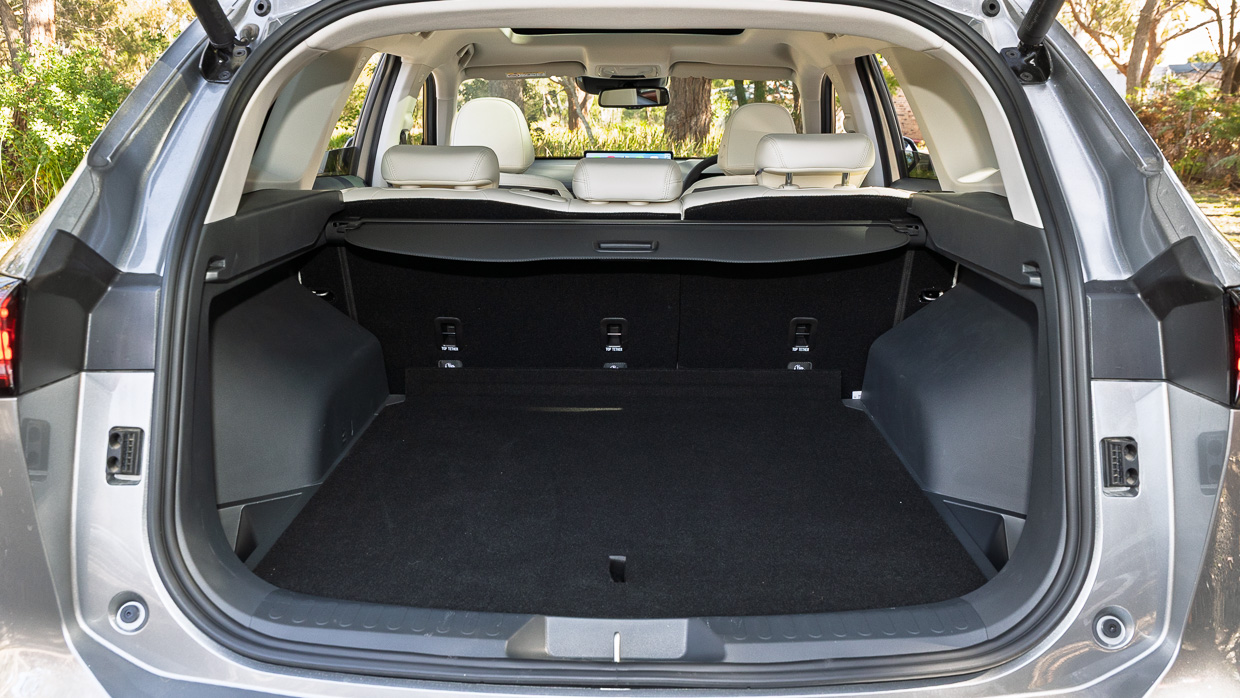
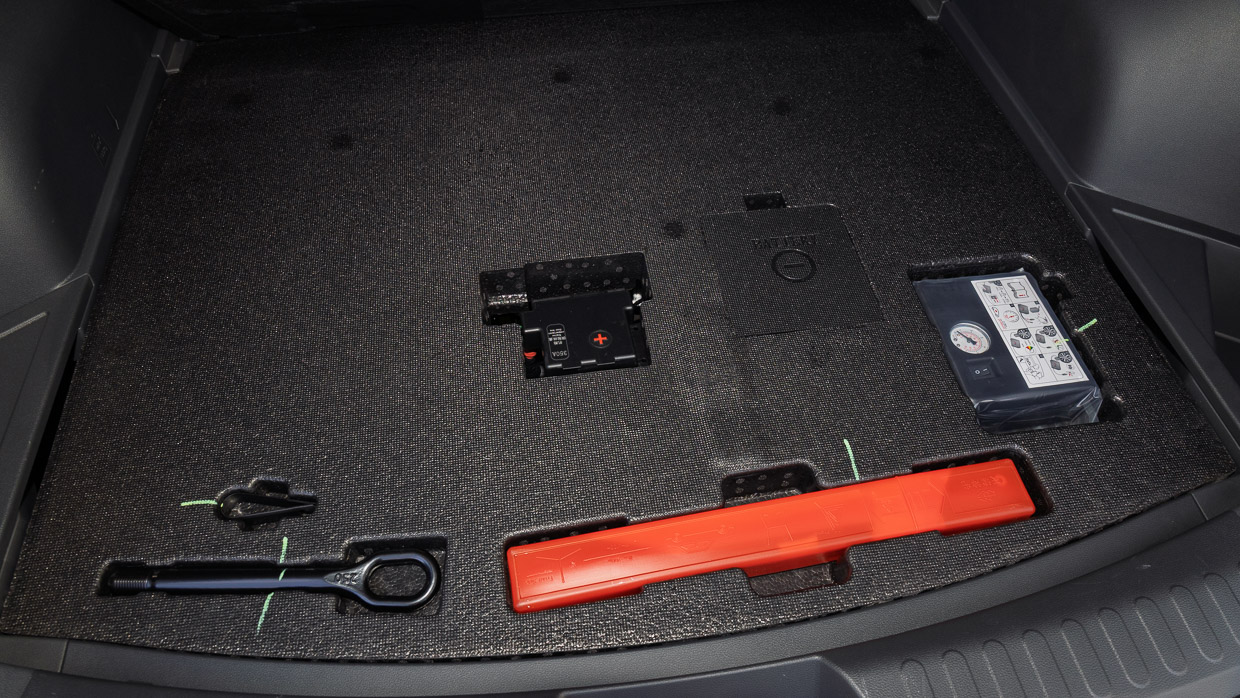
Boot space is 560 litres in five-seat mode and 1445L with the rear seats down (they split 60/40). The ICE has marginally more at 1485L.
Only the ICE version has a space saver spare; both hybrids make do with a tyre repair kit.
Is the H6 Ultra Hybrid a safe car?
As the latest round of updates to the Haval H6 are simply a facelift, the underlying vehicle continues to enjoy a five-star ANCAP safety rating under that body’s easier 2022 protocols – although GWM is believed to be in the process of renewing this.
Back in 2022, the H6 scored 90 percent for adult occupant protection, 88 percent for child occupant protection, 73 percent for vulnerable road user protection and 81 percent for safety assist technologies.
It’s worth remembering 2025 protocols are more challenging when trying to achieve the same result.

Impressively, safety kit is essentially standard across the range including forwards and reversing AEB, lane keeping assistance with lane centring, rear cross traffic alert with auto braking, traffic sign recognition, blind spot monitoring, and a 360-degree camera.
We were impressed with the camera’s clarity, making parking easy.
The tuning of the H6’s safety features was more deft than GWMs we have tested in the past, with relatively uninvasive lane-keeping (with variable sensitivity) and the ability to permanently deactivate speed monitoring sounds.
What are the H6 Ultra Hybrid’s ownership costs?
As tested in HEV form, the Haval H6 is fairly cheap to run. It isn’t as efficient as GWM claims but it’s still reasonably frugal on 91-octane petrol, servicing isn’t too expensive and it has a long warranty – all good things.
In terms of fuel economy, we beat GWM’s estimates on the highway but trailed the carmaker’s claims in town. We think there’s a clear reason for this.
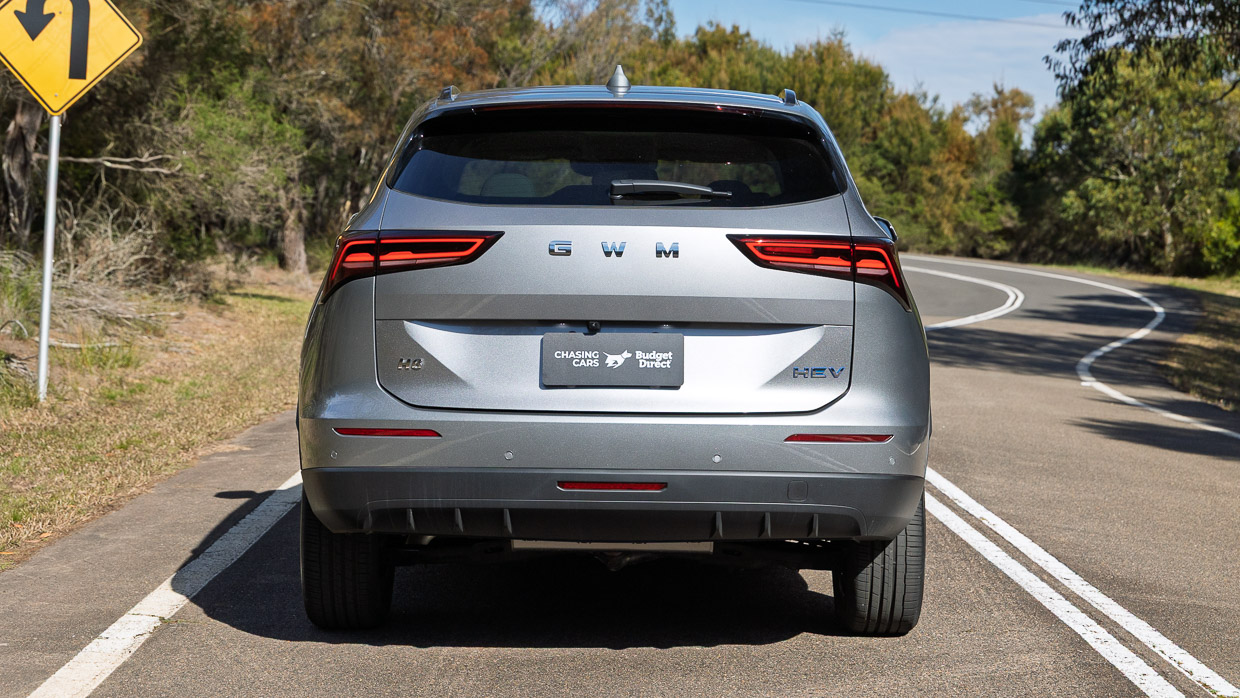
GWM claims 5.2L/100km combined for the H6 HEV, comprised of 6.2L/100km (highway) and just 3.5L/100km (urban).
We managed 6.0L/100km (highway) and 7.2L/100km (urban). The latter resulted from our testing in Sydney in winter, where morning and evening driving was generally between 7ºC and 12ºC.
We noticed the H6 HEV keeps its petrol engine on much longer after ignition than most hybrid rivals, driving up fuel consumption.
So we ran our urban fuel economy test again on a warmed-up engine and scored 6.0L/100km — still 70 percent higher than the claim…
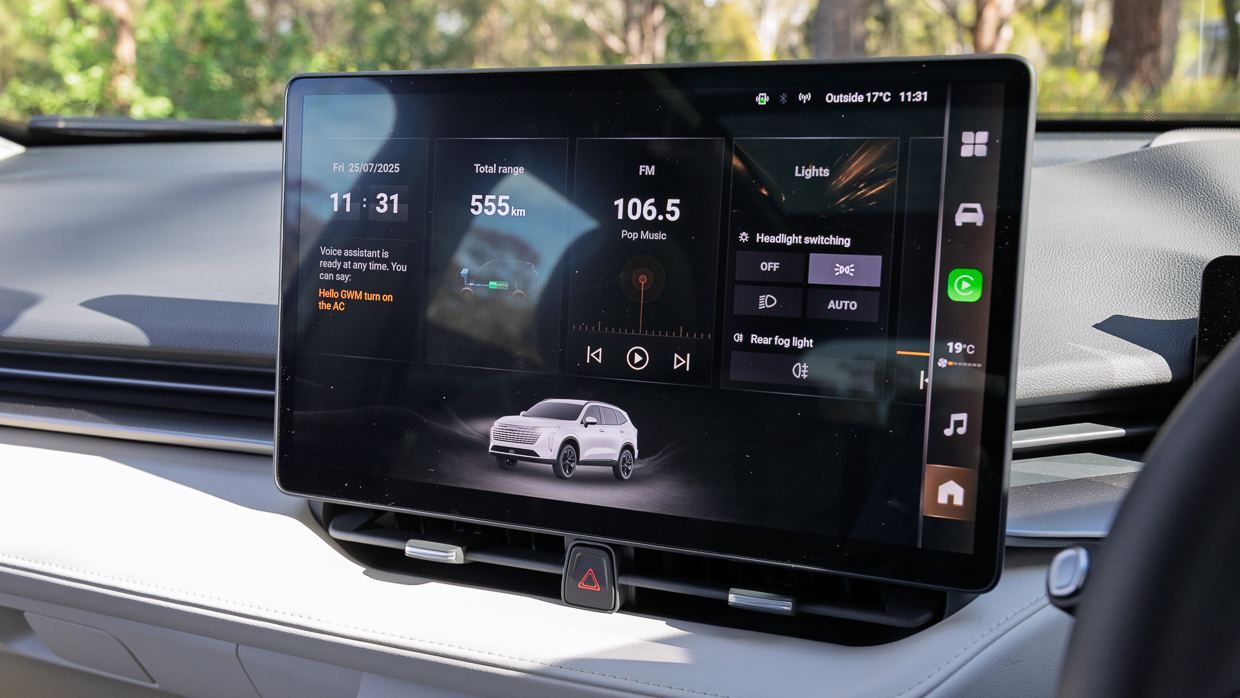
In any case, from its 61-litre fuel tank the H6’s real-world range sits between about 833km (urban in winter) and 1016km (highway), which is quite practical.
Servicing costs amount to $2020 over the first five years of ownership, with intervals generally falling at 12 months/15,000km—watch out for the first stop, though, which comes at 10,000km.
GWM offers a seven-year, unlimited kilometre warranty for both private and fleet customers, while the battery pack of the H6 HEV is covered for 70 percent state of health for eight years/150,000km.
The honest verdict on the H6 Ultra Hybrid
It’s very rare to see vehicle pricing drop these days, particularly when that reduction is accompanied by an extensive facelift that improves the appearance of the car.
Yet that’s precisely what happened to the GWM Haval H6 HEV Ultra. Now even cheaper, the $40,990 (driveaway) price of this lushly-equipped Chinese hybrid SUV seems extremely fair.
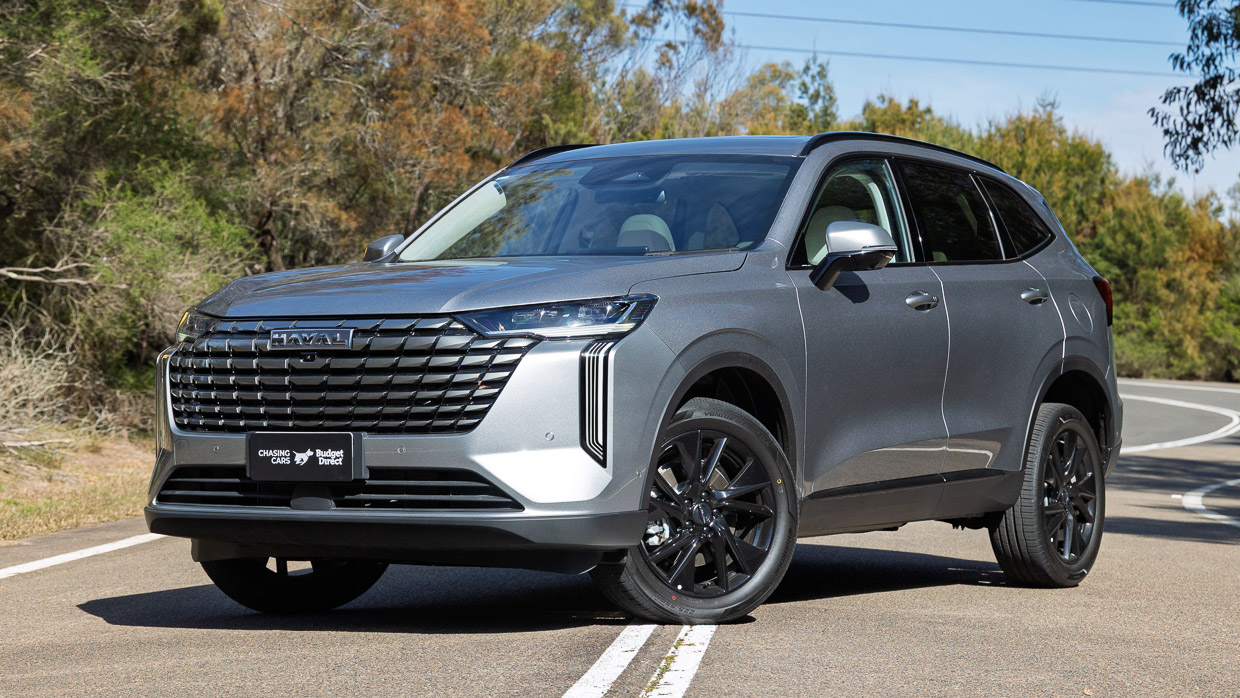
Sure, the H6 still doesn’t drive that well and there are elements to its interior we’d change (such as adding adjustable under-thigh support to the front seats) but the discount compared to established Japanese and Korean rivals is very significant indeed.
Still, we’d stop short of purchasing an H6 at this point.
With the knowledge that a talented Australian chassis engineer with a considerable portfolio of excellent cars has been unleashed on GWM’s lineup, the changes forthcoming to the ride and handling of its cars could be worth waiting for.
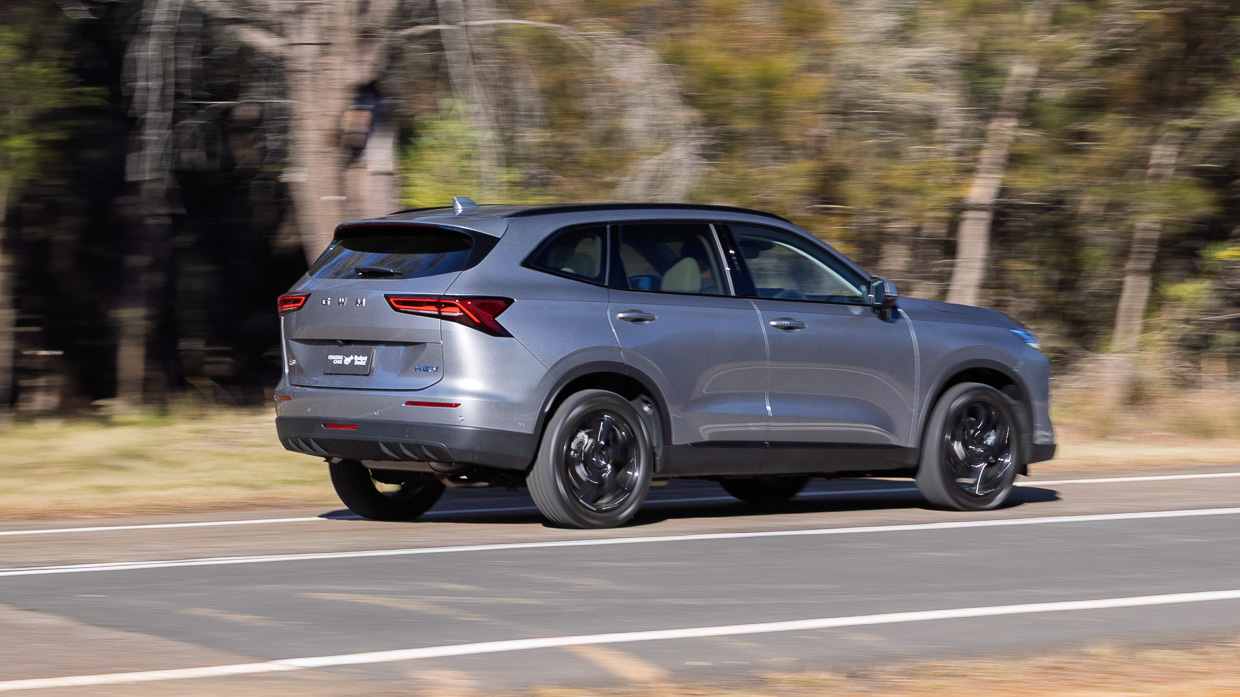
Given that ride quality and handling fluency are still problems for the H6, we’d wait and see if the forthcoming changes make it a better car to drive. If they result in a slightly higher price, we’d accept that.
Of more concern is that the powertrain also needs a rethink in terms of its software tuning. Whether such changes are on the horizon for the H6 HEV are unknown – but GWM should put that task on the agenda.



